#27 February 1860
Explore tagged Tumblr posts
Photo






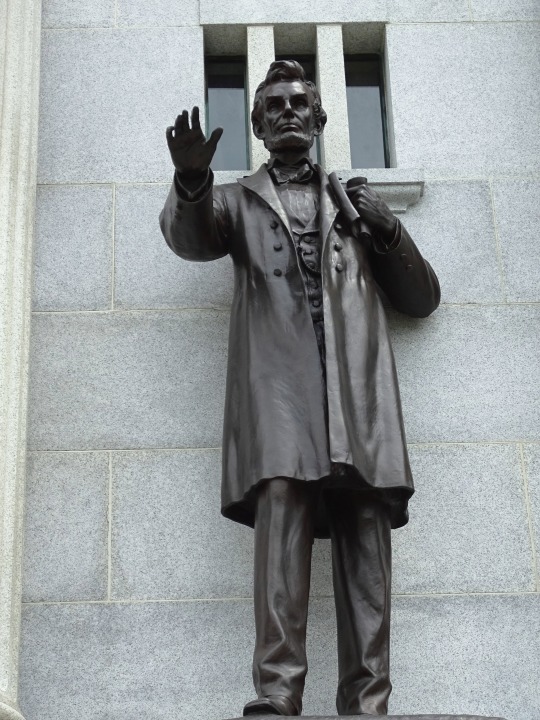



On February 27, 1860 Abraham Lincoln made a speech at Cooper Union in the city of New York that is largely responsible for his election to the Presidency. It is now referred to as the Cooper Union Address.
#The Cooper Union for the Advancement of Science and Art#Abraham Lincoln#speech#Cooper Union#Cooper Union Address#27 February 1860#USA#Manhattan#New York City#summer 2019#Cooper Union's Foundation Building#Italianate style#Fred A. Petersen#Stanley J. Watts#Gettysburg#travel#vacation#Mount Rushmore National Memorial#Gutzon Borglum#anniversary#US history
2 notes
·
View notes
Text
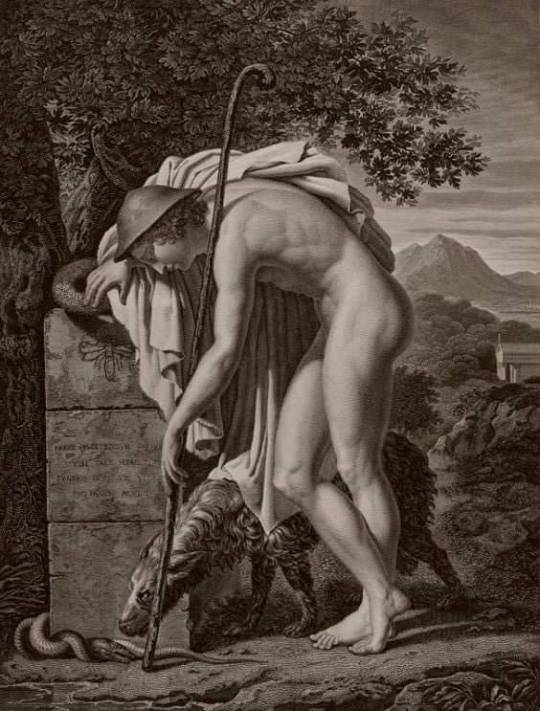
Antoine François Gelée is an engraver, lithographer and illustrator; French born in Paris, May 13, 1796 and died in the same city on February 27, 1860.
Virgil's Shepherd (Engraving)
66 notes
·
View notes
Text
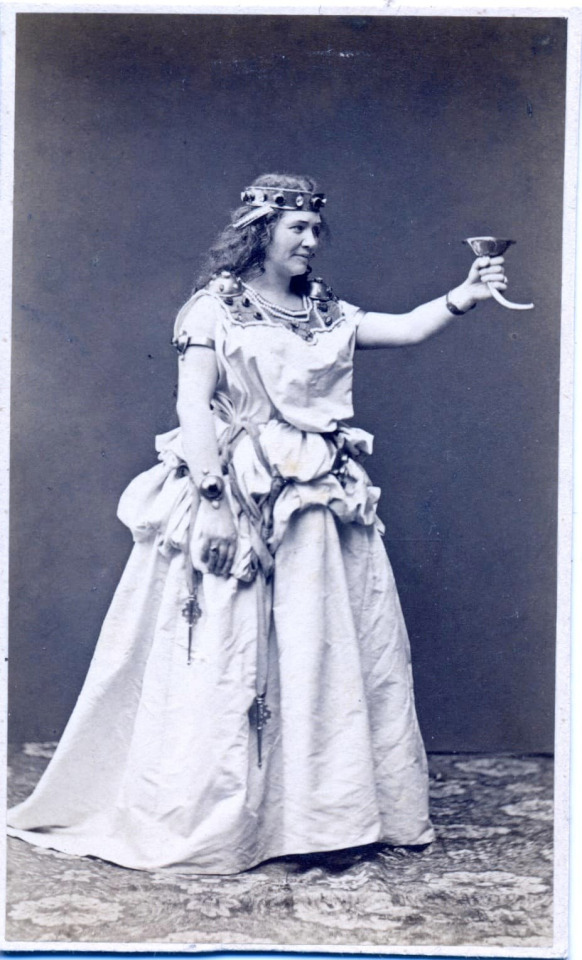
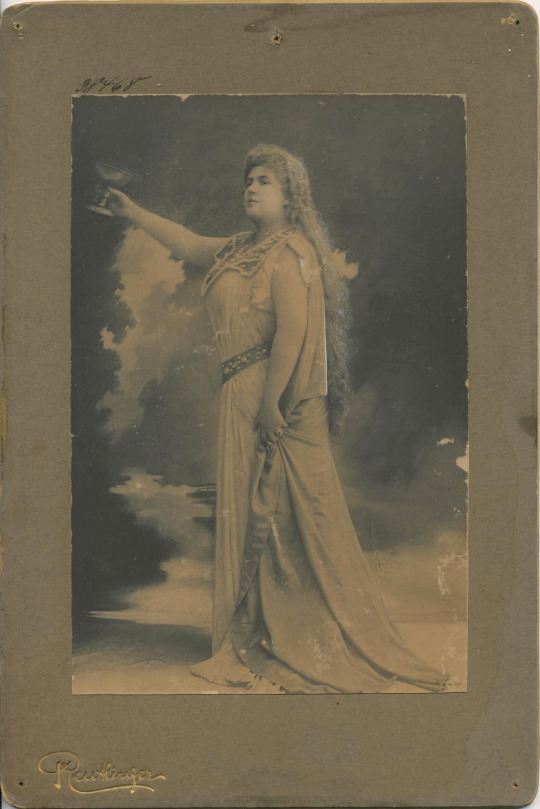


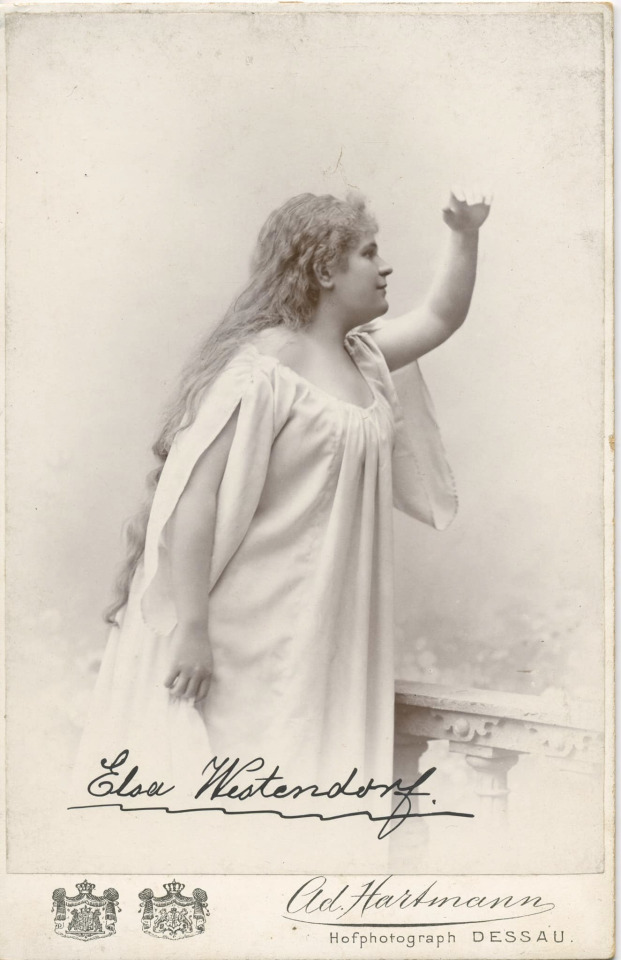

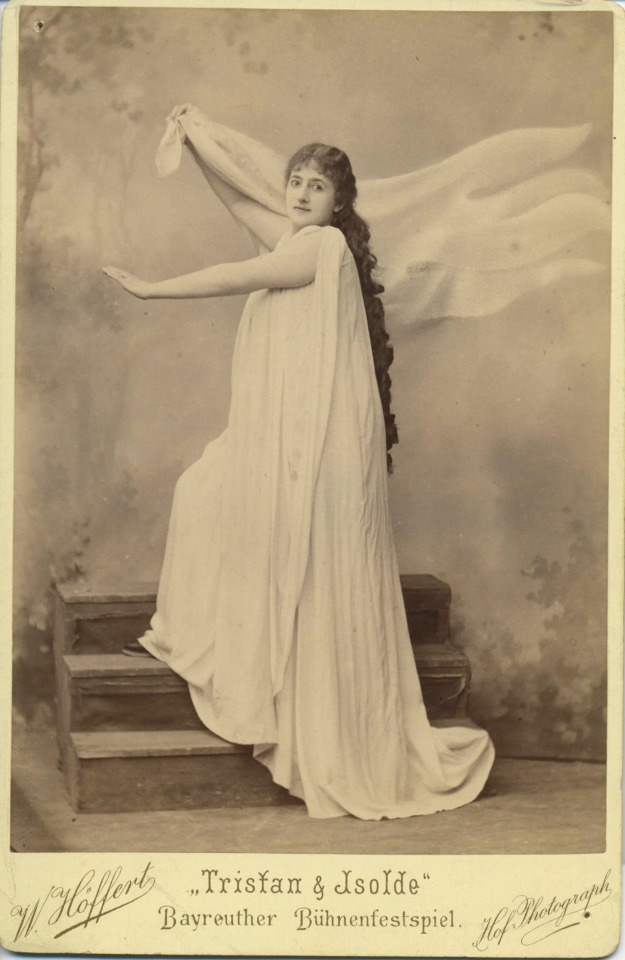

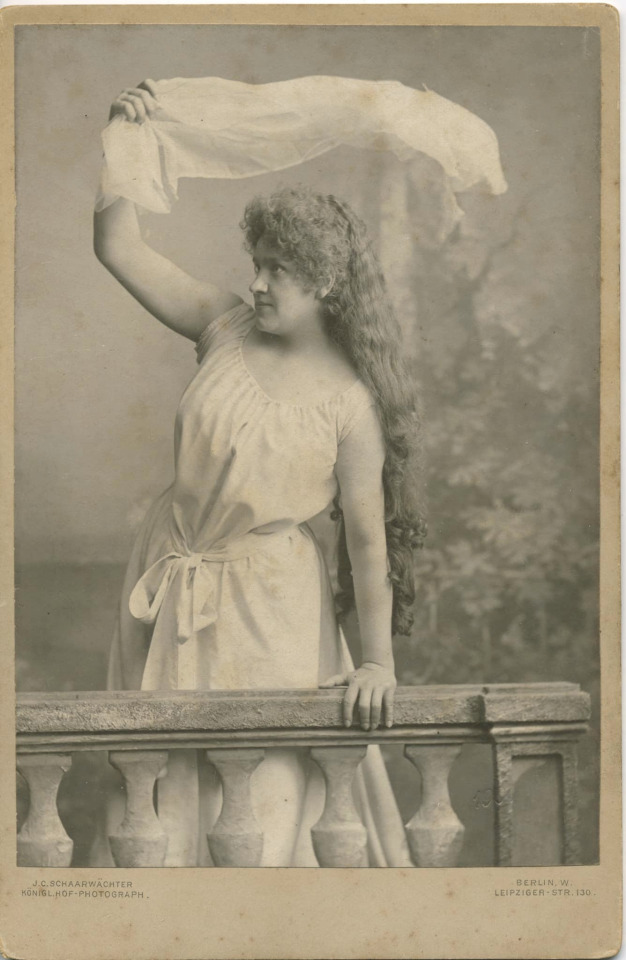
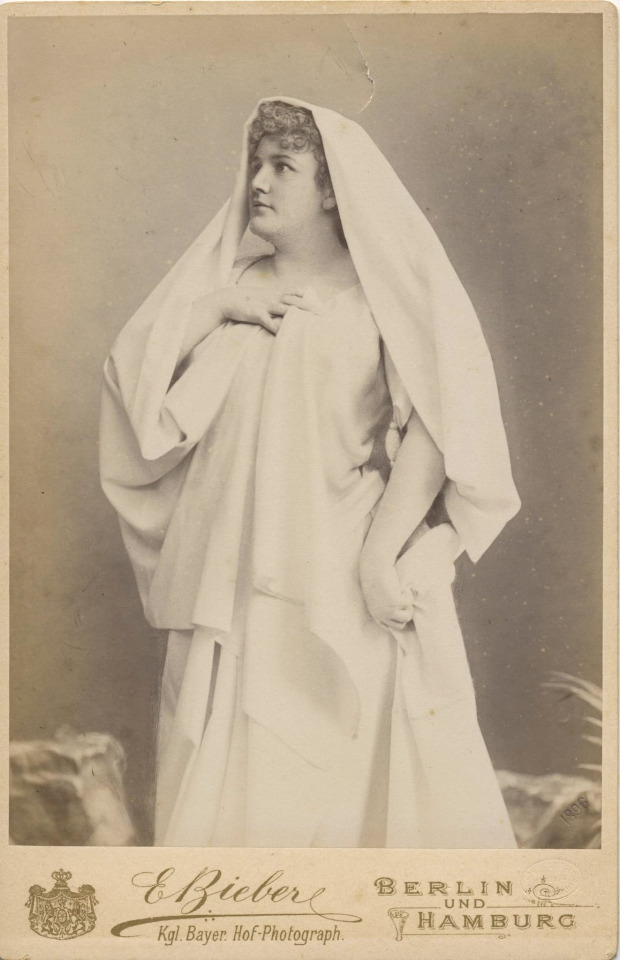

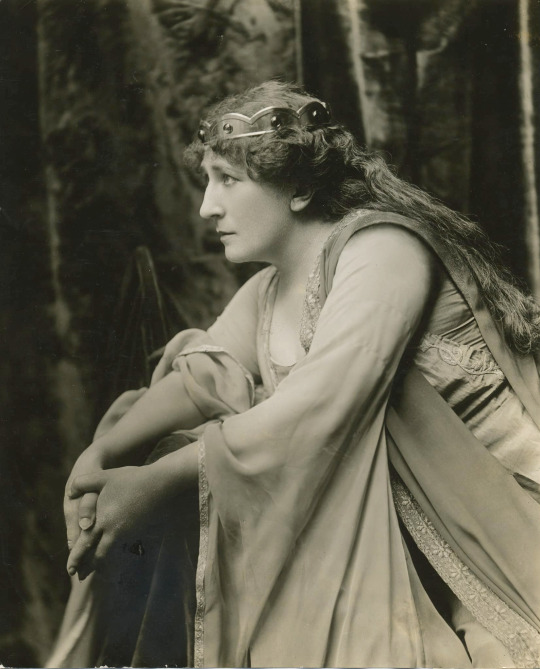
On June 10, 1865, the world premiere of "Tristan and Isolde" by R. Wagner took place in Munich.
„Mild und leise wie er lächelt…“
Here are some of the first sopranos to have sung the role of Isolde over the years and contributed to the success of this work through their dedication.
Malvina Schnoor von Carolsfeld, (7 December 1825 – 8 February 1904), Danish-born Portuguese dramatic soprano.
Felia Litvinne (11 October 1860, Saint Petersburg – 12 October 1936, Paris) was a Russian-born, French-based dramatic soprano.
Italia Vasquez-Molina (1869-1945), Italian soprano.
Irma von Voggenhuber (17 July 1841 Budapest - 11 January 1888 Berlin), soprano.
Elsa Westendorf (1877-1918), German soprano.
Marie Wittich 27 May 1868 – 4 August 1931), German dramatic soprano.
Rosa Sucher (23 February 1849 – 16 April 1927), German dramatic soprano.
Berta Pester-Prosky (Frankfurt am Main, September 7, 1866 - Krefeld, December 27, 1922), German soprano.
Thila Plaichinger (14 March 1868 – 19 March 1939), Austrian soprano.
Katharina Klafsky (19 September 1855 – 22 September 1896), Hungarian dramatic soprano.
Margot Kaftal (1873 Warsaw - October 1942 in Italy), Polish soprano.
Johanna Gadski (15 June 1870/1872 – 22 February 1932), German dramatic soprano.
#opera#classical music#music history#bel canto#composer#classical composer#aria#classical studies#Tristan and Isolde#classical musician#classical musicians#musician#musicians#classical history#historian of music#diva#prima donna#maestro#chest voice#Tristan und Isolde#Richard Wagner#Wagner#soprano#classical singer#classical singing#opera history#history#music
25 notes
·
View notes
Text

Strohs Brewery 991 Gratiot Ave
Stroh Brewing Company started with Johann Peter Stroh in 1775 in Kirn, Germany. Johann and his family lived in a house with an adjoining brew house attached, and ran a local inn that served meals and their family’s recipe for Bohemian-style Pilsner Ale. Johann had three sons and one daughter. His second son, Georg Freidrich Stroh, inherited the brew house. Georg’s youngest son was
Johann Bernhard Stroh (known to the world as Bernhard), who was born in 1821. On February 22, 1848, revolutions erupted across Europe. With all the turbulent violence surrounding Europe in the mid-19th century, and with his father Johann’s death and his elder brother Georg inheriting the family business, a 27 year old Bernhard Stroh, who had learned the brewing trade, immigrated to the United States.
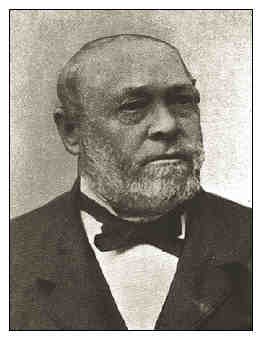
Bernhard Stroh arrived in the United States in 1850. He immediately started his own business. Stroh opened a brewery at 57 Catherine Street…He developed a market for a new light lager beer among the larger German immigrant population, and names his new company Lion’s Head Brewery, adopting the Lion’s Crest logo from Kyrburg Castle in Kirn, Germany.
The company uses this same crest as their logo to this day. With only an investment of $150 (in 2016 dollars, this would amount to $4,409.53) that he provided himself through working for the family inn back in Germany, Stroh had to be very frugal in his spending. By 1860, Stroh’s customers had a desire for Stroh to start bottling his famous beer so they could enjoy the Bohemian-style Pilsner Ale at their homes.

Bernhard Stroh would have his sons personally cart small kegs of beer to his customer’s homes and business by wheelbarrow.
Stroh’s would not only become Detroit’s largest brewer, but the third largest in the country.
This massive, million-square-foot factory at Gratiot near I-75 grew as the company did, with buildings dating from the 1860s to 1914. In late 1890, the firm Spier & Rohns was hired to make extensive additions and improvements to the Stroh campus, including building a 25-foot-by-70-foot fireproof stockhouse, a 60-foot-by-100-foot bottling works, and a new ice-machine plant. These additions made the brewery the largest in Michigan and formed some of the most visible parts of the plant.
By 1956, the Detroit brewery was pumping out 2.7 million barrels of beer — 83.7 million gallons.
he 1970s and 1980s were very productive years for the Stroh’s; sales continued to increase with the acquisition of Goebel’s, new leadership came in 1967 with John Stroh becoming CEO and Peter Stroh, Gari Stroh’s son, became President. The duo expanded the company to its greatest height throughout the two decades with new marketing and aggressive advertising strategies. With increased sales, the Stroh brewing company was able to match the big three car companies in terms of salaries and benefits. Early in the 1980’s, Peter Stroh started looking to take Stroh’s to the national stage, and made a bid on the Schaeffer Brewing Company and Schlitz Brewing Company. Schaeffer started to go into debt in the late 1970s and early ’80s, making the buyout from Stroh’s all too easy in 1981. Schlitz accepted a buyout offer of $17 a share. Schlitz became a wholly owned subsidiary of the Stroh Brewing Company, making Stroh the third-largest brewery in the United States. With all this expansion, Peter Stroh, now CEO at this time, realized his company was overextended. By 1985, Peter Stroh recognized his company was operating with excess capacity, On Feb. 8, 1985, Stroh’s announced it was closing its Detroit facility, calling it too costly to run and too inefficient compared with newer facilities it had acquired. The plant was shuttered that May, bringing an end to 135 years of tradition and costing 1,159 Detroiters their jobs.

The factory was imploded in two phases -- on April 13, 1986, and July 13, 1986 -- with the land soon redeveloped as Brewery Park.
In 1999, the struggling company was imploded, too, split up and sold to Miller Brewing and Pabst.
2 notes
·
View notes
Text
Someone wrote this as a factual historically backed response to the claim that somehow Democrats and Republicans changed sides.
June 17, 1854
The Republican Party is officially founded as an abolitionist party to slavery in the United States.
October 13, 1858
During the Lincoln-Douglas debates, U.S. Senator Stephen Douglas (D-IL) said, “If you desire negro citizenship, if you desire to allow them to come into the State and settle with the white man, if you desire them to vote on an equality with yourselves, and to make them eligible to office, to serve on juries, and to adjudge your rights, then support Mr. Lincoln and the Black Republican party, who are in favor of the citizenship of the negro. For one, I am opposed to negro citizenship in any and every form. I believe this Government was made on the white basis. I believe it was made by white men for the benefit of white men and their posterity for ever, and I am in favor of confining citizenship to white men, men of European birth and descent, instead of conferring it upon negroes, Indians, and other inferior races.”. Douglas became the Democrat Party’s 1860 presidential nominee.
April 16, 1862
President Lincoln signed the bill abolishing slavery in the District of Columbia. In Congress, almost every Republican voted for yes and most Democrats voted no.
July 17, 1862
Over unanimous Democrat opposition, the Republican Congress passed The Confiscation Act stating that slaves of the Confederacy “shall be forever free”.
April 8, 1864
The 13th Amendment banning slavery passed the U.S. Senate with 100% Republican support, 63% Democrat opposition.
January 31, 1865
The 13th Amendment banning slavery passed the U.S. House with unanimous Republican support and intense Democrat opposition.November 22, 1865
Republicans denounced the Democrat legislature of Mississippi for enacting the “black codes” which institutionalized racial discrimination.
February 5, 1866
U.S. Rep. Thaddeus Stevens (R-PA) introduced legislation (successfully opposed by Democrat President Andrew Johnson) to implement “40 acres and a mule” relief by distributing land to former slaves.
March 27, 1866
Democrat President Andrew Johnson vetoes of law granting voting rights to blacks.
May 10, 1866
The U.S. House passed the Republicans’ 14th Amendment guaranteeing due process and equal protection of the laws to all citizens. 100% of Democrats vote no.
June 8, 1866
The U.S. Senate passed the Republicans’ 14th Amendment guaranteeing due process and equal protection of the law to all citizens. 94% of Republicans vote yes and 100% of Democrats vote no.
March 27, 1866
Democrat President Andrew Johnson vetoes of law granting voting rights to blacks in the District of Columbia.
July 16, 1866
The Republican Congress overrode Democrat President Andrew Johnson’s veto of legislation protecting the voting rights of blacks.
March 30, 1868
Republicans begin the impeachment trial of Democrat President Andrew Johnson who declared, “This is a country for white men, and by God, as long as I am President, it shall be a government of white men.”September 12, 1868
Civil rights activist Tunis Campbell and 24 other blacks in the Georgia Senate (all Republicans) were expelled by the Democrat majority and would later be reinstated by the Republican Congress.
October 7, 1868
Republicans denounced Democrat Party’s national campaign theme: “This is a white man’s country: Let white men rule.”
October 22, 1868
While campaigning for re-election, Republican U.S. Rep. James Hinds (R-AR) was assassinated by Democrat terrorists who organized as the Ku Klux Klan. Hinds was the first sitting congressman to be murdered while in office.
December 10, 1869
Republican Gov. John Campbell of the Wyoming Territory signed the FIRST-in-nation law granting women the right to vote and hold public office.
February 3, 1870
After passing the House with 98% Republican support and 97% Democrat opposition, Republicans’ 15th Amendment was ratified, granting the vote to ALL Americans regardless of race.
February 25, 1870
Hiram Rhodes Revels (R-MS) becomes the first black to be seated in the United States Senate.
May 31, 1870
President U.S. Grant signed the Republicans’ Enforcement Act providing stiff penalties for depriving any American’s civil rights.
June 22, 1870
Ohio Rep. Williams Lawrence created the U.S. Department of Justice to safeguard the civil rights of blacks against Democrats in the South.
September 6, 1870
Women voted in Wyoming in first election after women’s suffrage signed into law by Republican Gov. John Campbell.
February 1, 1871
Rep. Jefferson Franklin Long (R-GA) became the first black to speak on the floor of the U.S. House of Representatives.
February 28, 1871
The Republican Congress passed the Civil Rights Act of 1871 providing federal protection for black voters.
April 20, 1871
The Republican Congress enacted the Ku Klux Klan Act, outlawing Democrat Party-affiliated terrorist groups which oppressed blacks and all those who supported them.
October 10, 1871
Following warnings by Philadelphia Democrats against black voting, Republican civil rights activist Octavius Catto was murdered by a Democrat Party operative. His military funeral was attended by thousands.
October 18, 1871
After violence against Republicans in South Carolina, President Ulysses Grant deployed U.S. troops to combat Democrat Ku Klux Klan terrorists.
November 18, 1872
Susan B. Anthony was arrested for voting after boasting to Elizabeth Cady Stanton that she voted for “Well, I have gone and done it — positively voted the straight Republican ticket.”January 17, 1874
Armed Democrats seized the Texas state government, ending Republican efforts to racially integrate.
September 14, 1874
Democrat white supremacists seized the Louisiana statehouse in attempt to overthrow the racially-integrated administration of Republican Governor William Kellogg. Twenty-seven were killed.
March 1, 1875
The Civil Rights Act of 1875, guaranteeing access to public accommodations without regard to race, was signed by Republican President U.S. Grant and passed with 92% Republican support over 100% Democrat opposition.
January 10, 1878
U.S. Senator Aaron Sargent (R-CA) introduced the Susan B. Anthony amendment for women’s suffrage. The Democrat-controlled Senate defeated it four times before the election of a Republican House and Senate that guaranteed its approval in 1919.
February 8, 1894
The Democrat Congress and Democrat President Grover Cleveland joined to repeal the Republicans’ Enforcement Act which had enabled blacks to vote.
January 15, 1901
Republican Booker T. Washington protested the Alabama Democrat Party’s refusal to permit voting by blacks.
May 29, 1902
Virginia Democrats implemented a new state constitution condemned by Republicans as illegal, reducing black voter registration by almost 90%.
February 12, 1909
On the 100th anniversary of Abraham Lincoln’s birth, black Republicans and women’s suffragists Ida Wells and Mary Terrell co-founded the National Association for the Advancement of Colored People.
May 21, 1919
The Republican House passed a constitutional amendment granting women the vote with 85% of Republicans and only 54% of Democrats in favor. In the Senate 80% of Republicans voted yes and almost half of Democrats voted no.
August 18, 1920
The Republican-authored 19th Amendment giving women the right to vote became part of the Constitution. Twenty-six of the 36 states needed to ratify had Republican-controlled legislatures.
January 26, 1922
The House passed a bill authored by U.S. Rep. Leonidas Dyer (R-MO) making lynching a federal crime. Senate Democrats blocked it by filibuster.
June 2, 1924
Republican President Calvin Coolidge signed a bill passed by the Republican Congress granting U.S. citizenship to all Native Americans.
October 3, 1924
Republicans denounced three-time Democrat presidential nominee William Jennings Bryan for defending the Ku Klux Klan at the 1924 Democratic National Convention.
June 12, 1929
First Lady Lou Hoover invited the wife of black Rep. Oscar De Priest (R-IL) to tea at the White House, sparking protests by Democrats across the country.
August 17, 1937
Republicans organized opposition to former Ku Klux Klansman and Democrat U.S. Senator Hugo Black who was later appointed to the U.S. Supreme Court by FDR. Black’s Klan background was hidden until after confirmation.
June 24, 1940
The Republican Party platform called for the integration of the Armed Forces. For the balance of his terms in office, President Franklin Delano Roosevelt (D) refused to order it.
August 8, 1945
Republicans condemned Harry Truman’s surprise use of the atomic bomb in Japan. It began two days after the Hiroshima bombing when former Republican President Herbert Hoover wrote that “The use of the atomic bomb, with its indiscriminate killing of women and children, revolts my soul.”
May 17, 1954
Earl Warren, California’s three-term Republican Governor and 1948 Republican vice presidential nominee, was nominated to be Chief Justice delivered the landmark decision “Brown v. Board of Education”.
November 25, 1955
Republican President Dwight D. Eisenhower’s administration banned racial segregation of interstate bus travel.
March 12, 1956
Ninety-seven Democrats in Congress condemned the Supreme Court’s “Brown v. Board of Education” decision and pledged (Southern Manifesto) to continue segregation.
June 5, 1956
Republican federal judge Frank Johnson ruled in favor of the Rosa Parks decision striking down the “blacks in the back of the bus” law.
November 6, 1956
African-American civil rights leaders Martin Luther King and Ralph Abernathy voted for Republican Dwight Eisenhower for President.
September 9, 1957
President Eisenhower signed the Republican Party’s 1957 Civil Rights Act.
September 24, 1957
Sparking criticism from Democrats such as Senators John Kennedy and Lyndon Johnson, President Eisenhower deployed the 82nd Airborne Division to Little Rock, AR to force Democrat Governor Orval Faubus to integrate their public schools.
May 6, 1960
President Eisenhower signed the Republicans’ Civil Rights Act of 1960, overcoming a 125-hour, ’round-the-clock filibuster by 18 Senate Democrats.
May 2, 1963
Republicans condemned Bull Connor, the Democrat “Commissioner of Public Safety” in Birmingham, AL for arresting over 2,000 black schoolchildren marching for their civil rights.
September 29, 1963
Gov. George Wallace (D-AL) defied an order by U.S. District Judge Frank Johnson (appointed by President Dwight Eisenhower) to integrate Tuskegee High School.
June 9, 1964
Republicans condemned the 14-hour filibuster against the 1964 Civil Rights Act by U.S. Senator and former Ku Klux Klansman Robert Byrd (D-WV), who served in the Senate until his death in 2010.
June 10, 1964
Senate Minority Leader Everett Dirksen (R-IL) criticized the Democrat filibuster against 1964 Civil Rights Act and called on Democrats to stop opposing racial equality. The Civil Rights Act of 1964 was introduced and approved by a majority of Republicans in the Senate. The Act was opposed by most southern Democrat senators, several of whom were proud segregationists — one of them being Al Gore Sr. (D). President Lyndon B. Johnson relied on Illinois Senator Everett Dirksen, the Republican leader from Illinois, to get the Act passed.
August 4, 1965
Senate Leader Everett Dirksen (R-IL) overcame Democrat attempts to block 1965 Voting Rights Act. Ninety-four percent of Republicans voted for the landmark civil rights legislation while 27% of Democrats opposed. The Voting Rights Act of 1965, abolishing literacy tests and other measures devised by Democrats to prevent blacks from voting, was signed into law. A higher percentage of Republicans voted in favor.
February 19, 1976
President Gerald Ford formally rescinded President Franklin D. Roosevelt’s notorious Executive Order 9066 authorizing the internment of over 120,000 Japanese-Americans during WWII.
September 15, 1981
President Ronald Reagan established the White House Initiative on Historically Black Colleges and Universities to increase black participation in federal education programs.
June 29, 1982
President Ronald Reagan signed a 25-year extension of the 1965 Voting Rights Act.
August 10, 1988
President Ronald Reagan signed the Civil Liberties Act of 1988, compensating Japanese-Americans for the deprivation of their civil rights and property during the World War II internment ordered by FDR.
November 21, 1991
President George H. W. Bush signed the Civil Rights Act of 1991 to strengthen federal civil rights legislation.
August 20, 1996
A bill authored by U.S. Rep. Susan Molinari (R-NY) to prohibit racial discrimination in adoptions, part of Republicans’ “Contract With America”, became law.
July 2, 2010
Clinton says Byrd joined KKK to help him get elected
Just a “fleeting association”. Nothing to see here.
Only a willing fool (and there quite a lot out there) would accept and recite the nonsensical that one bright, sunny day Democrats and Republicans just up and decided to “switch” political positions and cite the “Southern Strategy” as the uniform knee-jerk retort. Even today, it never takes long for a Democrat to play the race card purely for political advantage.Thanks to the Democrat Party, blacks have the distinction of being the only group in the United States whose history is a work-in-progress.
The idea that “the Dixiecrats joined the Republicans” is not quite true, as you note. But because of Strom Thurmond it is accepted as a fact. What happened is that the **next** generation (post 1965) of white southern politicians — Newt, Trent Lott, Ashcroft, Cochran, Alexander, etc — joined the GOP.So it was really a passing of the torch as the old segregationists retired and were replaced by new young GOP guys. One particularly galling aspect to generalizations about “segregationists became GOP” is that the new GOP South was INTEGRATED for crying out loud, they accepted the Civil Rights revolution. Meanwhile, Jimmy Carter led a group of what would become “New” Democrats like Clinton and Al Gore.
There weren’t many Republicans in the South prior to 1964, but that doesn’t mean the birth of the southern GOP was tied to “white racism.” That said, I am sure there were and are white racist southern GOP. No one would deny that. But it was the southern Democrats who were the party of slavery and, later, segregation. It was George Wallace, not John Tower, who stood in the southern schoolhouse door to block desegregation! The vast majority of Congressional GOP voted FOR the Civil Rights of 1964-65. The vast majority of those opposed to those acts were southern Democrats. Southern Democrats led to infamous filibuster of the 1964 Civil Rights Act.The confusion arises from GOP Barry Goldwater’s vote against the ’64 act. He had voted in favor or all earlier bills and had led the integration of the Arizona Air National Guard, but he didn’t like the “private property” aspects of the ’64 law. In other words, Goldwater believed people’s private businesses and private clubs were subject only to market forces, not government mandates (“We reserve the right to refuse service to anyone.”) His vote against the Civil Rights Act was because of that one provision was, to my mind, a principled mistake.This stance is what won Goldwater the South in 1964, and no doubt many racists voted for Goldwater in the mistaken belief that he opposed Negro Civil Rights. But Goldwater was not a racist; he was a libertarian who favored both civil rights and property rights.Switch to 1968.Richard Nixon was also a proponent of Civil Rights; it was a CA colleague who urged Ike to appoint Warren to the Supreme Court; he was a supporter of Brown v. Board, and favored sending troops to integrate Little Rock High). Nixon saw he could develop a “Southern strategy” based on Goldwater’s inroads. He did, but Independent Democrat George Wallace carried most of the deep south in 68. By 1972, however, Wallace was shot and paralyzed, and Nixon began to tilt the south to the GOP. The old guard Democrats began to fade away while a new generation of Southern politicians became Republicans. True, Strom Thurmond switched to GOP, but most of the old timers (Fulbright, Gore, Wallace, Byrd etc etc) retired as Dems.Why did a new generation white Southerners join the GOP? Not because they thought Republicans were racists who would return the South to segregation, but because the GOP was a “local government, small government” party in the old Jeffersonian tradition. Southerners wanted less government and the GOP was their natural home.Jimmy Carter, a Civil Rights Democrat, briefly returned some states to the Democrat fold, but in 1980, Goldwater’s heir, Ronald Reagan, sealed this deal for the GOP. The new “Solid South” was solid GOP.BUT, and we must stress this: the new southern Republicans were *integrationist* Republicans who accepted the Civil Rights revolution and full integration while retaining their love of Jeffersonian limited government principles.
Oh wait, princess, I am not done yet.
Where Teddy Roosevelt invited Booker T. Washington to dinner, Woodrow Wilson re-segregated the U.S. government and had the pro-Klan film “Birth of a Nation” screened in his White House.
Wilson and FDR carried all 11 states of the Old Confederacy all six times they ran, when Southern blacks had no vote. Disfranchised black folks did not seem to bother these greatest of liberal icons.
As vice president, FDR chose “Cactus Jack” Garner of Texas who played a major role in imposing a poll tax to keep blacks from voting.
Among FDR’s Supreme Court appointments was Hugo Black, a Klansman who claimed FDR knew this when he named him in 1937 and that FDR told him that “some of his best friends” in Georgia were Klansmen.
Black’s great achievement as a lawyer was in winning acquittal of a man who shot to death the Catholic priest who had presided over his daughter’s marriage to a Puerto Rican.
In 1941, FDR named South Carolina Sen. “Jimmy” Byrnes to the Supreme Court. Byrnes had led filibusters in 1935 and 1938 that killed anti-lynching bills, arguing that lynching was necessary “to hold in check the Negro in the South.”
FDR refused to back the 1938 anti-lynching law.
“This is a white man’s country and will always remain a white man’s country,” said Jimmy. Harry Truman, who paid $10 to join the Klan, then quit, named Byrnes Secretary of State, putting him first in line of succession to the presidency, as Harry then had no V.P.
During the civil rights struggles of the ‘50s and ‘60s, Gov. Orval Faubus used the National Guard to keep black students out of Little Rock High. Gov. Ross Barnett refused to let James Meredith into Ole Miss. Gov. George Wallace stood in the door at the University of Alabama, to block two black students from entering.
All three governors were Democrats. All acted in accord with the “Dixie Manifesto” of 1956, which was signed by 19 senators, all Democrats, and 80 Democratic congressmen.
Among the signers of the manifesto, which called for massive resistance to the Brown decision desegregating public schools, was the vice presidential nominee on Adlai’s Stevenson’s ticket in 1952, Sen. John Sparkman of Alabama.
Though crushed by Eisenhower, Adlai swept the Deep South, winning both Carolinas, Georgia, Alabama, Mississippi, Louisiana and Arkansas.
Do you suppose those Southerners thought Adlai would be tougher than Ike on Stalin? Or did they think Adlai would maintain the unholy alliance of Southern segregationists and Northern liberals that enabled Democrats to rule from 1932 to 1952?
The Democratic Party was the party of slavery, secession and segregation, of “Pitchfork Ben” Tillman and the KKK. “Bull” Connor, who turned the dogs loose on black demonstrators in Birmingham, was the Democratic National Committeeman from Alabama.
And Nixon?
In 1956, as vice president, Nixon went to Harlem to declare, “America can’t afford the cost of segregation.” The following year, Nixon got a personal letter from Dr. King thanking him for helping to persuade the Senate to pass the Civil Rights Act of 1957.
Nixon supported the civil rights acts of 1964, 1965 and 1968.
In the 1966 campaign, as related in my new book “The Greatest Comeback: How Richard Nixon Rose From Defeat to Create the New Majority,” out July 8, Nixon blasted Dixiecrats “seeking to squeeze the last ounces of political juice out of the rotting fruit of racial injustice.”
Nixon called out segregationist candidates in ‘66 and called on LBJ, Hubert Humphrey and Bobby Kennedy to join him in repudiating them. None did. Hubert, an arm around Lester Maddox, called him a “good Democrat.” And so were they all – good Democrats.
While Adlai chose Sparkman, Nixon chose Spiro Agnew, the first governor south of the Mason Dixon Line to enact an open-housing law.
In Nixon’s presidency, the civil rights enforcement budget rose 800 percent. Record numbers of blacks were appointed to federal office. An Office of Minority Business Enterprise was created. SBA loans to minorities soared 1,000 percent. Aid to black colleges doubled.
Nixon won the South not because he agreed with them on civil rights – he never did – but because he shared the patriotic values of the South and its antipathy to liberal hypocrisy.
When Johnson left office, 10 percent of Southern schools were desegregated.
When Nixon left, the figure was 70 percent. Richard Nixon desegregated the Southern schools, something you won’t learn in today’s public schools.
Not done there yet, snowflake.
1964:George Romney, Republican civil rights activist. That Republicans have let Democrats get away with this mountebankery is a symptom of their political fecklessness, and in letting them get away with it the GOP has allowed itself to be cut off rhetorically from a pantheon of Republican political heroes, from Abraham Lincoln and Frederick Douglass to Susan B. Anthony, who represent an expression of conservative ideals as true and relevant today as it was in the 19th century.
Perhaps even worse, the Democrats have been allowed to rhetorically bury their Bull Connors, their longstanding affiliation with the Ku Klux Klan, and their pitiless opposition to practically every major piece of civil-rights legislation for a century.
Republicans may not be able to make significant inroads among black voters in the coming elections, but they would do well to demolish this myth nonetheless.
Even if the Republicans’ rise in the South had happened suddenly in the 1960s (it didn’t) and even if there were no competing explanation (there is), racism — or, more precisely, white southern resentment over the political successes of the civil-rights movement — would be an implausible explanation for the dissolution of the Democratic bloc in the old Confederacy and the emergence of a Republican stronghold there.
That is because those southerners who defected from the Democratic Party in the 1960s and thereafter did so to join a Republican Party that was far more enlightened on racial issues than were the Democrats of the era, and had been for a century.
There is no radical break in the Republicans’ civil-rights history: From abolition to Reconstruction to the anti-lynching laws, from the Fourteenth and Fifteenth Amendments to the Civil Rights Act of 1875 to the Civil Rights Acts of 1957, 1960, and 1964, there exists a line that is by no means perfectly straight or unwavering but that nonetheless connects the politics of Lincoln with those of Dwight D. Eisenhower.
And from slavery and secession to remorseless opposition to everything from Reconstruction to the anti-lynching laws, the Fourteenth and Fifteenth Amendments, the Civil Rights Act of 1875, and the Civil Rights Acts of 1957 and 1960, there exists a similarly identifiable line connecting John Calhoun and Lyndon Baines Johnson.
Supporting civil-rights reform was not a radical turnaround for congressional Republicans in 1964, but it was a radical turnaround for Johnson and the Democrats.
The depth of Johnson’s prior opposition to civil-rights reform must be digested in some detail to be properly appreciated.
In the House, he did not represent a particularly segregationist constituency (it “made up for being less intensely segregationist than the rest of the South by being more intensely anti-Communist,” as the New York Times put it), but Johnson was practically antebellum in his views.
Never mind civil rights or voting rights: In Congress, Johnson had consistently and repeatedly voted against legislation to protect black Americans from lynching.
As a leader in the Senate, Johnson did his best to cripple the Civil Rights Act of 1957; not having votes sufficient to stop it, he managed to reduce it to an act of mere symbolism by excising the enforcement provisions before sending it to the desk of President Eisenhower.
Johnson’s Democratic colleague Strom Thurmond nonetheless went to the trouble of staging the longest filibuster in history up to that point, speaking for 24 hours in a futile attempt to block the bill.
The reformers came back in 1960 with an act to remedy the deficiencies of the 1957 act, and Johnson’s Senate Democrats again staged a record-setting filibuster.
In both cases, the “master of the Senate” petitioned the northeastern Kennedy liberals to credit him for having seen to the law’s passage while at the same time boasting to southern Democrats that he had taken the teeth out of the legislation.
Johnson would later explain his thinking thus: “These Negroes, they’re getting pretty uppity these days, and that’s a problem for us, since they’ve got something now they never had before: the political pull to back up their uppityness. Now we’ve got to do something about this — we’ve got to give them a little something, just enough to quiet them down, not enough to make a difference.”
Johnson did not spring up from the Democratic soil ex nihilo.
Not one Democrat in Congress voted for the Fourteenth Amendment.
Not one Democrat in Congress voted for the Fifteenth Amendment.
Not one voted for the Civil Rights Act of 1875.
Dwight Eisenhower as a general began the process of desegregating the military, and Truman as president formalized it, but the main reason either had to act was that President Woodrow Wilson, the personification of Democratic progressivism, had resegregated previously integrated federal facilities. (“If the colored people made a mistake in voting for me, they ought to correct it,” he declared.)
Klansmen from Senator Robert Byrd to Justice Hugo Black held prominent positions in the Democratic Party — and President Wilson chose the Klan epic Birth of a Nation to be the first film ever shown at the White House.
Johnson himself denounced an earlier attempt at civil-rights reform as the “nigger bill.” So what happened in 1964 to change Democrats’ minds? In fact, nothing.
President Johnson was nothing if not shrewd, and he knew something that very few popular political commentators appreciate today: The Democrats began losing the “solid South” in the late 1930s — at the same time as they were picking up votes from northern blacks.
The Civil War and the sting of Reconstruction had indeed produced a political monopoly for southern Democrats that lasted for decades, but the New Deal had been polarizing. It was very popular in much of the country, including much of the South — Johnson owed his election to the House to his New Deal platform and Roosevelt connections — but there was a conservative backlash against it, and that backlash eventually drove New Deal critics to the Republican Party.
Likewise, adherents of the isolationist tendency in American politics, which is never very far from the surface, looked askance at what Bob Dole would later famously call “Democrat wars” (a factor that would become especially relevant when the Democrats under Kennedy and Johnson committed the United States to a very divisive war in Vietnam).
The tiniest cracks in the Democrats’ southern bloc began to appear with the backlash to FDR’s court-packing scheme and the recession of 1937.
Republicans would pick up 81 House seats in the 1938 election, with West Virginia’s all-Democrat delegation ceasing to be so with the acquisition of its first Republican.
Kentucky elected a Republican House member in 1934, as did Missouri, while Tennessee’s first Republican House member, elected in 1918, was joined by another in 1932.
Throughout the 1940s and 1950s, the Republican Party, though marginal, began to take hold in the South — but not very quickly: Dixie would not send its first Republican to the Senate until 1961, with Texas’s election of John Tower.
At the same time, Republicans went through a long dry spell on civil-rights progress.
Many of them believed, wrongly, that the issue had been more or less resolved by the constitutional amendments that had been enacted to ensure the full citizenship of black Americans after the Civil War, and that the enduring marginalization of black citizens, particularly in the Democratic states, was a problem that would be healed by time, economic development, and organic social change rather than through a second political confrontation between North and South.
As late as 1964, the Republican platform argued that “the elimination of any such discrimination is a matter of heart, conscience, and education, as well as of equal rights under law.”
The conventional Republican wisdom of the day held that the South was backward because it was poor rather than poor because it was backward.
And their strongest piece of evidence for that belief was that Republican support in the South was not among poor whites or the old elites — the two groups that tended to hold the most retrograde beliefs on race.
Instead, it was among the emerging southern middle class.
This fact was recently documented by professors Byron Shafer and Richard Johnston in The End of Southern Exceptionalism: Class, Race, and Partisan Change in the Postwar South (Harvard University Press, 2006).
Which is to say: The Republican rise in the South was contemporaneous with the decline of race as the most important political question and tracked the rise of middle-class voters moved mainly by economic considerations and anti-Communism.
The South had been in effect a Third World country within the United States, and that changed with the post-war economic boom.
As Clay Risen put it in the New York Times: “The South transformed itself from a backward region to an engine of the national economy, giving rise to a sizable new wealthy suburban class.
This class, not surprisingly, began to vote for the party that best represented its economic interests: the GOP. Working-class whites, however — and here’s the surprise — even those in areas with large black populations, stayed loyal to the Democrats.
This was true until the 90s, when the nation as a whole turned rightward in Congressional voting.” The mythmakers would have you believe that it was the opposite: that your white-hooded hillbilly trailer-dwelling tornado-bait voters jumped ship because LBJ signed a civil-rights bill (passed on the strength of disproportionately Republican support in Congress). The facts suggest otherwise. There is no question that Republicans in the 1960s and thereafter hoped to pick up the angry populists who had delivered several states to Wallace.
That was Patrick J. Buchanan’s portfolio in the Nixon campaign.
But in the main they did not do so by appeal to racial resentment, direct or indirect.
The conservative ascendency of 1964 saw the nomination of Barry Goldwater, a western libertarian who had never been strongly identified with racial issues one way or the other, but who was a principled critic of the 1964 act and its extension of federal power.
Goldwater had supported the 1957 and 1960 acts but believed that Title II and Title VII of the 1964 bill were unconstitutional, based in part on a 75-page brief from Robert Bork.
But far from extending a welcoming hand to southern segregationists, he named as his running mate a New York representative, William E. Miller, who had been the co-author of Republican civil-rights legislation in the 1950s.
The Republican platform in 1964 was hardly catnip for Klansmen: It spoke of the Johnson administration’s failure to help further the “just aspirations of the minority groups” and blasted the president for his refusal “to apply Republican-initiated retraining programs where most needed, particularly where they could afford new economic opportunities to Negro citizens.”
Other planks in the platform included: “improvements of civil rights statutes adequate to changing needs of our times; such additional administrative or legislative actions as may be required to end the denial, for whatever unlawful reason, of the right to vote; continued opposition to discrimination based on race, creed, national origin or sex.”
And Goldwater’s fellow Republicans ran on a 1964 platform demanding “full implementation and faithful execution of the Civil Rights Act of 1964, and all other civil rights statutes, to assure equal rights and opportunities guaranteed by the Constitution to every citizen.” Some dog whistle.
Of course there were racists in the Republican Party. There were racists in the Democratic Party. The case of Johnson is well documented, while Nixon had his fantastical panoply of racial obsessions, touching blacks, Jews, Italians (“Don’t have their heads screwed on”), Irish (“They get mean when they drink”), and the Ivy League WASPs he hated so passionately (“Did one of those dirty bastards ever invite me to his f***ing men’s club or goddamn country club? Not once”).
But the legislative record, the evolution of the electorate, the party platforms, the keynote speeches — none of them suggests a party-wide Republican about-face on civil rights.
Neither does the history of the black vote.
While Republican affiliation was beginning to grow in the South in the late 1930s, the GOP also lost its lock on black voters in the North, among whom the New Deal was extraordinarily popular.
By 1940, Democrats for the first time won a majority of black votes in the North. This development was not lost on Lyndon Johnson, who crafted his Great Society with the goal of exploiting widespread dependency for the benefit of the Democratic Party.
Unlike the New Deal, a flawed program that at least had the excuse of relying upon ideas that were at the time largely untested and enacted in the face of a worldwide economic emergency, Johnson’s Great Society was pure politics.
Johnson’s War on Poverty was declared at a time when poverty had been declining for decades, and the first Job Corps office opened when the unemployment rate was less than 5 percent.
Congressional Republicans had long supported a program to assist the indigent elderly, but the Democrats insisted that the program cover all of the elderly — even though they were, then as now, the most affluent demographic, with 85 percent of them in households of above-average wealth.
Democrats such as Secretary of Health, Education, and Welfare Anthony J. Celebrezze argued that the Great Society would end “dependency” among the elderly and the poor, but the programs were transparently designed merely to transfer dependency from private and local sources of support to federal agencies created and overseen by Johnson and his political heirs.
In the context of the rest of his program, Johnson’s unexpected civil-rights conversion looks less like an attempt to empower blacks and more like an attempt to make clients of them.
If the parties had in some meaningful way flipped on civil rights, one would expect that to show up in the electoral results in the years following the Democrats’ 1964 about-face on the issue.
Nothing of the sort happened: Of the 21 Democratic senators who opposed the 1964 act, only one would ever change parties.
Nor did the segregationist constituencies that elected these Democrats throw them out in favor of Republicans: The remaining 20 continued to be elected as Democrats or were replaced by Democrats.
It was, on average, nearly a quarter of a century before those seats went Republican. If southern rednecks ditched the Democrats because of a civil-rights law passed in 1964, it is strange that they waited until the late 1980s and early 1990s to do so. They say things move slower in the South — but not that slow.
Republicans did begin to win some southern House seats, and in many cases segregationist Democrats were thrown out by southern voters in favor of civil-rights Republicans.
One of the loudest Democratic segregationists in the House was Texas’s John Dowdy.
Dowdy was a bitter and buffoonish opponent of the 1964 reforms.
He declared the reforms “would set up a despot in the attorney general’s office with a large corps of enforcers under him; and his will and his oppressive action would be brought to bear upon citizens, just as Hitler’s minions coerced and subjugated the German people.
Dowdy went on: “I would say this — I believe this would be agreed to by most people: that, if we had a Hitler in the United States, the first thing he would want would be a bill of this nature.” (Who says political rhetoric has been debased in the past 40 years?)
Dowdy was thrown out in 1966 in favor of a Republican with a very respectable record on civil rights, a little-known figure by the name of George H. W. Bush.
It was in fact not until 1995 that Republicans represented a majority of the southern congressional delegation — and they had hardly spent the Reagan years campaigning on the resurrection of Jim Crow.
It was not the Civil War but the Cold War that shaped midcentury partisan politics.
Eisenhower warned the country against the “military-industrial complex,” but in truth Ike’s ascent had represented the decisive victory of the interventionist, hawkish wing of the Republican Party over what remained of the America First/Charles Lindbergh/Robert Taft tendency.
The Republican Party had long been staunchly anti-Communist, but the post-war era saw that anti-Communism energized and looking for monsters to slay, both abroad — in the form of the Soviet Union and its satellites — and at home, in the form of the growing welfare state, the “creeping socialism” conservatives dreaded.
By the middle 1960s, the semi-revolutionary Left was the liveliest current in U.S. politics, and Republicans’ unapologetic anti-Communism — especially conservatives’ rhetoric connecting international socialism abroad with the welfare state at home — left the Left with nowhere to go but the Democratic Party. Vietnam was Johnson’s war, but by 1968 the Democratic Party was not his alone.
The schizophrenic presidential election of that year set the stage for the subsequent transformation of southern politics: Segregationist Democrat George Wallace, running as an independent, made a last stand in the old Confederacy but carried only five states.
Republican Richard Nixon, who had helped shepherd the 1957 Civil Rights Act through Congress, counted a number of Confederate states (North Carolina, South Carolina, Florida, and Tennessee) among the 32 he carried.
Democrat Hubert Humphrey was reduced to a northern fringe plus Texas.
Mindful of the long-term realignment already under way in the South, Johnson informed Democrats worried about losing it after the 1964 act that “those states may be lost anyway.”
Subsequent presidential elections bore him out: Nixon won a 49-state sweep in 1972, and, with the exception of the post-Watergate election of 1976, Republicans in the following presidential elections would more or less occupy the South like Sherman.
Bill Clinton would pick up a handful of southern states in his two contests, and Barack Obama had some success in the post-southern South, notably Virginia and Florida.
The Republican ascendancy in Dixie is associated with several factors: The rise of the southern middle class, The increasingly trenchant conservative critique of Communism and the welfare state, The Vietnam controversy, The rise of the counterculture, law-and-order concerns rooted in the urban chaos that ran rampant from the late 1960s to the late 1980s, and The incorporation of the radical Left into the Democratic party.
Individual events, especially the freak show that was the 1968 Democratic convention, helped solidify conservatives’ affiliation with the Republican Party. Democrats might argue that some of these concerns — especially welfare and crime — are “dog whistles” or “code” for race and racism. However, this criticism is shallow in light of the evidence and the real saliency of those issues among U.S. voters of all backgrounds and both parties for decades. Indeed, Democrats who argue that the best policies for black Americans are those that are soft on crime and generous with welfare are engaged in much the same sort of cynical racial calculation President Johnson was practicing. Johnson informed skeptical southern governors that his plan for the Great Society was “to have them niggers voting Democratic for the next two hundred years.” Johnson’s crude racism is, happily, largely a relic of the past, but his strategy endures.
5 notes
·
View notes
Text
Matilda Byers - Midwife
Last month I was researching the Byers branch of my husband’s family tree. The Byers branch resided in St. Clair County, Alabama after the antebellum period. While looking at St. Clair County birth registers, the name of Matilda Byers appeared as an informant on births of known collateral Byers ancestors.
Matilda Byers is on the official list of doctors and midwives in the 1899-1906 Register of Births for St. Clair County, Alabama.[1]
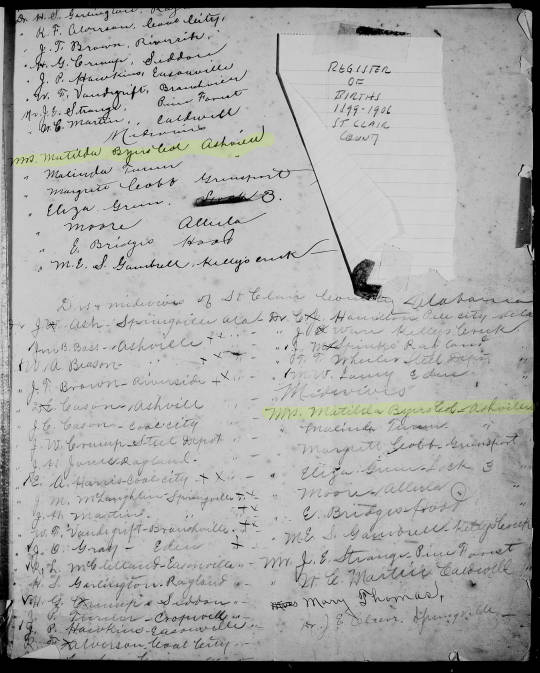
St. Clair County, Alabama, Register of Births, 1899-1906 : “Mrs. Matilda Byers".
How Matilda became a midwife is unknown. The usual path to this occupation was through an apprenticeship with an experienced midwife. Before childbirth was medicalized, about 50% of all babies were delivered by midwives.[2] Prior to 1940 the percentage of midwife-attended births in the African American communities in Alabama would have been more than 75%.[3]
Matilda Byers is recorded as the midwife for several collateral ancestors in my husband’s family tree:
1895 - A son of Lee and Malinda Byers. [4]
1902 - A son of Lee and Malinda Byers. [5]
1913 - Child of Rich and “Dealey” [Delia] Woods. [6]
1913 - Child of Jessie and Pearl Kidd. [7]
NOTE: Lee Byers (1860-1909) is my husband’s granduncle. Delia Byers (1894-1941) and Pearl Byers (1889-1964) are the daughters of Lee Byers. Delia and her sister Pearl are my husband’s 1st cousins, once removed (1C1R).
Very little is known about Matilda Byers. Records show that Matilda Loony married Hudson Byers on 7 November 1867 in St. Clair County, Alabama.[8] She and her husband Hudson Byers are in my on-line and off-line records as “unverified”.
Sources
St. Clair County, Alabama, Register of Births, 1899-1906 : front of book, for “Mrs. Matilda Byers Col Ashville”; imaged, “Alabama, County Birth Registers, 1881-1930,” FamilySearch (https://www.familysearch.org/ark:/61903/3:1:33S7-9B3R-3KM : accessed 6 June 2024) > digital film 5176112 > image 126 of 792; citing St. Clair County Probate Court, Ashville.
Dominique Tobbell, “Black Midwifery’s Complex History,” 21 February 2021, UVA School of Nursing: News (https://www.nursing.virginia.edu/news/bhm-black-midwives : accessed 5 June 2024).
Helen Varney and Joyce Beebe Thompson, A History of Midwifery in the United States: The Midwife Said Fear Not (New York : Springer Publishing, 2015), 10.
St. Clair County, Alabama, Register of Births, 1893-98 : 31 January 1895 entry for male child of Malinda Byers and Lee Byers; imaged “Alabama, County Birth Registers, 1881-1930,” FamilySearch (https://www.familysearch.org/ark:/61903/1:1:WXY5-DSMM : accessed 6 June 2024) > digital file 5176112 > image 48 of 124.
St. Clair County, Alabama, Register of Births, 1899-1906 : 19 January 1902 entry for male child of Malinda Byers and Lee Byers, certificate 19 ; imaged “Alabama, County Birth Registers, 1881-1930,” FamilySearch (https://www.familysearch.org/ark:/61903/1:1:WXY6-JMT2 : accessed 6 June 2024) > digital file 5176112 > image 61 of 128.
St. Clair County, Alabama, Register of Births and Deaths [January 1913 - May 1916] : 22-23, 18 June 1913 entry for female child of “Dealey” Woods and Rich Woods; imaged “Alabama, County Birth Registers, 1881-1930,” FamilySearch (https://www.familysearch.org/ark:/61903/1:1:WDXQ-TVZM : accessed 23 May 2024) > digital file 8501930 > images 26-27 of 283.
St. Clair County, Alabama, County Birth Registers [January 1913 - May 1916] : 22-23, 16 June 1913 entry for male child of Pearl Kidd and Jessie Kidd; imaged “Alabama, County Birth Registers, 1881-1930,” FamilySearch (https://www.familysearch.org/ark:/61903/1:1:WDXQ-TVPZ : accessed 23 May 2024) > digital file 8501930 > images 26-27 of 283.
St. Clair County, Alabama, Marriage Record 1866-1887 : 24, Hudson Byers and Matilda Loony, 7 November 1867; imaged as “Alabama County Marriages, 1809-1950,” FamilySearch (https://www.familysearch.org/ark:/61903/3:1:3QS7-99HV-CB65 : accessed 6 June 2024) > digital file 7316689 > image 119 of 733.
0 notes
Text
Events 2.27 (before 1940)
380 – Edict of Thessalonica: Emperor Theodosius I and his co-emperors Gratian and Valentinian II declare their wish that all Roman citizens convert to Nicene Christianity. 425 – The University of Constantinople is founded by Emperor Theodosius II at the urging of his wife Aelia Eudocia. 907 – Abaoji, chieftain of the Yila tribe, is named khagan of the Khitans. 1560 – The Treaty of Berwick is signed by England and the Lords of the Congregation of Scotland, establishing the terms under which English armed forces were to be permitted in Scotland in order to expel occupying French troops. 1594 – Henry IV is crowned King of France. 1617 – Sweden and the Tsardom of Russia sign the Treaty of Stolbovo, ending the Ingrian War and shutting Russia out of the Baltic Sea. 1626 – Yuan Chonghuan is appointed Governor of Liaodong, after leading the Chinese into a great victory against the Manchurians under Nurhaci. 1776 – American Revolutionary War: The Battle of Moore's Creek Bridge in North Carolina breaks up a Loyalist militia. 1782 – American Revolutionary War: The House of Commons of Great Britain votes against further war in America. 1801 – Pursuant to the District of Columbia Organic Act of 1801, Washington, D.C. is placed under the jurisdiction of the U.S. Congress. 1809 – Action of 27 February 1809: Captain Bernard Dubourdieu captures HMS Proserpine. 1812 – Argentine War of Independence: Manuel Belgrano raises the Flag of Argentina in the city of Rosario for the first time. 1812 – Poet Lord Byron gives his first address as a member of the House of Lords, in defense of Luddite violence against Industrialism in his home county of Nottinghamshire. 1844 – The Dominican Republic gains independence from Haiti. 1860 – Abraham Lincoln makes a speech at Cooper Union in the city of New York that is largely responsible for his election to the Presidency. 1864 – American Civil War: The first Northern prisoners arrive at the Confederate prison at Andersonville, Georgia. 1870 – The current flag of Japan is first adopted as the national flag for Japanese merchant ships. 1881 – First Boer War: The Battle of Majuba Hill takes place. 1898 – King George I of Greece survives an assassination attempt. 1900 – Second Boer War: In South Africa, British military leaders receive an unconditional notice of surrender from Boer General Piet Cronjé at the Battle of Paardeberg. 1900 – The British Labour Party is founded. 1900 – Fußball-Club Bayern München is founded. 1902 – Second Boer War: Australian soldiers Harry "Breaker" Morant and Peter Handcock are executed in Pretoria after being convicted of war crimes. 1916 – Ocean liner SS Maloja strikes a mine near Dover and sinks with the loss of 155 lives. 1921 – The International Working Union of Socialist Parties is founded in Vienna. 1922 – A challenge to the Nineteenth Amendment to the United States Constitution, allowing women the right to vote, is rebuffed by the Supreme Court of the United States in Leser v. Garnett. 1932 – The Mäntsälä rebellion begins when members of the far-right Lapua Movement start shooting at the social democrats' event in Mäntsälä, Finland. 1933 – Reichstag fire: Germany's parliament building in Berlin, the Reichstag, is set on fire; Marinus van der Lubbe, a young Dutch Communist claims responsibility. 1939 – United States labor law: The U.S. Supreme Court rules in NLRB v. Fansteel Metallurgical Corp. that the National Labor Relations Board has no authority to force an employer to rehire workers who engage in sit-down strikes.
0 notes
Text

THE DESCRIPTION OF SAINT GABRIEL OF THE SEVEN SORROWS (Francesco Possenti) Feast Day: February 27
"Our perfection does not consist of doing extraordinary things but to do the ordinary well."
St. Gabriel's life reveals that a profound love for the Mother of Sorrows is of the very essence of the Passionist charism, for it was Mary who appeared to young Paul Francis Daneo, the Passionist founder, and called him to found the Congregation.
Francisco Possenti was born in Assisi on March 1, 1838, the eleventh child of Sante Possenti and Agnes Frisciotti.
The first year of his life was spent away from his family with a nursing woman who cared for him because his mother was unable. In 1841 Sante moved the family to Spoleto where he was appointed magistrate. In that same year, the youngest Possenti child died at just six months old; Francis' nine-year old sister, Adele, soon followed. Just days later, his heartbroken mother was too called to eternal life. Francis had lost his mother at just 4 years old.
Tragedy continued to plague the family during his youth. In 1846 Francis' brother, Paul, was killed in the Italian war with Austria. Another brother, Lawrence, later took his own life. Such events, however, did not rob Francis of his spirit and cheerfulness. During his formative years, Francis attended the school of the Christian brothers and then the Jesuit college in Spoleto. He was lively, intelligent and popular at school. At sixteen, he suffered a life-threatening illness. Praying for a cure, Francis promised to become a religious. With recovery, however, Francis quickly forgot his promise. But God's call would not be denied, and Francis soon turned his heart to the Congregation of the Passionists.
Francisco was less than pleased with his teenage son's decision. Determined to show Francis the joys of a secular life of theater and society parties, Sante continued to hope Francis would find pleasure in a social life. But the young man was not to be dissuaded. Immediately after completion of his schooling, he left for the Passionist novitiate in Morrovalle. In the novitiate, he cultivated a great love for Christ Crucified. Francis received the Passionist habit on September 21, 1856, which that year was the Feast of the Sorrowful Mother.
He was given the name: Gabriel of the Sorrowful Mother. A year later he took his vows.
His monastic life preparing for the priesthood made Gabriel a secluded, non-public figure. His writings reflect his close relationship with God and His mother.
These were difficult and tumultuous times in Italy. The new Italian government issued decrees closing religious Orders in certain provinces of the Papal States. The new Passionist province of Pieta, to which Gabriel belonged, was in the center of this chaos. By 1860, the Passionists had ceased apostolic work due to the growing threats surrounding the community. During this period various Italian provinces were overrun by soldiers who robbed and terrorized the towns with little mercy.
The people of Isola would always remember him as 'their Gabriel.'
Struck with tuberculosis at the age of 24, Gabriel died on February 27, 1862, before his ordination to the priesthood. His fidelity to prayer, joyfulness of spirit and habitual mortifications stand out in his otherwise ordinary life.
Pope Benedict XV canonized Gabriel in 1920 and declared him a patron of Catholic youth. His patronage is also invoked by the Church for students, seminarians, novices and clerics. Thousands of divine favors are attributed to his intercession with Christ Crucified and the Sorrowful Mother Mary.
#random stuff#catholic#catholic saints#passionists#francesco possenti#gabriel possenti#gabriel of our lady of sorrows
0 notes
Text
Five steps of Wikipedia for Tuesday, 13th February 2024
Welcome, karibu, velkommen, მოგესალმებით (mogesalmebit) 🤗 Five steps of Wikipedia from "Tim Paulson" to "1840 United States census". 🪜👣

Start page 👣🏁: Tim Paulson "Timothy Dale Paulson (born November 27, 1952) is a California labor leader, who currently serves as the Secretary-Treasurer of the San Francisco Building and Construction Trades Council after being unanimously elected in July 2018, and sworn in by San Francisco Mayor London Breed...."

Image licensed under CC BY-SA 4.0? by Tim Paulson
Step 1️⃣ 👣: California "California is a state in the Western region of the United States. It borders Oregon to the north, Nevada and Arizona to the east, and the Mexican state of Baja California to the south; it has a coastline along the Pacific Ocean to the west. With over 38.9 million residents across a total area of..."

Image by
Original: Donald Graeme Kelley
Vectorization: Devin Cook
Step 2️⃣ 👣: 1860 United States census "The 1860 United States census was the eighth census conducted in the United States starting June 1, 1860, and lasting five months. It determined the population of the United States to be 31,443,322 in 33 states and 10 organized territories. This was an increase of 35.4 percent over the 23,069,876..."

Image
Step 3️⃣ 👣: 1820 United States census "The 1820 United States census was the fourth census conducted in the United States. It was conducted on August 7, 1820. The 1820 census included six new states: Louisiana, Indiana, Mississippi, Illinois, Alabama and Maine. There has been a district wide loss of 1820 census records for Arkansas..."

Image by USMS Publishing & Multimedia Services
Step 4️⃣ 👣: 1890 United States census "The 1890 United States census was taken beginning June 2, 1890. The census determined the resident population of the United States to be 62,979,766, an increase of 25.5 percent over the 50,189,209 persons enumerated during the 1880 census. The data reported that the distribution of the population..."

Image by United States Department of the Interior
Step 5️⃣ 👣: 1840 United States census "The 1840 United States census was the sixth census of the United States. Conducted by U.S. marshals on June 1, 1840, it determined the resident population of the United States to be 17,069,453 – an increase of 32.7 percent over the 12,866,020 persons enumerated during the 1830 census. The total..."

Image by USMS Publishing & Multimedia Services
0 notes
Text
The history of the History Center, Part II
By Jonathan Monfiletto

A trustee of the Yates County History Center once asked me to look into the happenings of the History Center from the time it was founded in 1860 as the Yates County Historical Society until it was re-chartered in the 1920s as the Yates County Genealogical and Historical Society. My answer back to him was, indeed I could not find much of a record of activity of the historical society from about the mid-1880s until the late-1920s when the organization was re-formed.
In fact, from its incorporation on February 4, 1860, the Yates County Historical Society – despite being founded and operated by some of the pioneers of the county and their descendants – seems to have petered out rather quickly. Within a quarter of a century, the organization may have gone dormant – or it may just not have been as active and noticed in the community as it once was.
A newspaper notice dated December 18, 1885 states: “Why not reorganize the Yates County Historical Society? … We should be very glad to see this society placed on solid footing. There is a vacancy in the office of President. Important work could and ought to be done this winter. What say the members of the Society to a thoro [sic] organization.” However, an article in the Penn Yan Express of May 11, 1887 carries the proceedings of the Historical Society’s annual meeting, so perhaps the latter statement in the last sentence of the above paragraph is the true one.
Still, the Historical Society did apparently go dormant or extinct over the next 20 years or so. Beginning November 29, 1907, the Rushville Chronicle (whose content largely seems to duplicate that of the Yates County Chronicle) put calls out for the group. “If some of the people of Penn Yan would get together and call a meeting for the organization of a Yates County Historical Society there are a number of interested citizens of Jerusalem who would gladly join in such a commendable enterprise,” the first notice states. “Many interesting and important matters would thus be conserved, and new developments would be brought to light that are in the background, and which would be of inestimable value. The shadows of time too swiftly obliterate the footprints of our race. Every township in Yates county is storied with a rich fund of local history, wanting only the patient research of one who loves the work of developing the facts, to render a service of signal gratification to many people of the present period and of greater moment to succeeding generations, as the only means of any information of the people and events of the past upon the soil and scenes of the newly inhabitants. Every true man has a just pride in his ancestral domain, and will treasure its history, if developed, and perpetuate it as an heir loom [sic]. Who will start the nucleus in Penn Yan? Other counties have flourishing Historical Societies. Why not our own loved Yates?”
On March 27, 1908, the Rushville Chronicle (and probably the Yates County Chronicle) asserted: “Yates county furnishes abundant material to warrant the organization of a historical society. Little Yates is rich in tradition, in incident and in interesting experiences. … We trust the matter of organizing a Yates County Historical Society will receive active encouragement. There are an abundance of reasons why it should exist.” In response, on April 10, 1908, Miles A. Davis wrote to the newspapers: “I, for one, most heartily approve your recent suggestive article for the organization of a Yates County Historical Society. There is a wealth of historical material in every township which can be developed and conserved through organization, with stated meetings and suitable quarters.”
Nearly a decade later, the Rushville Chronicle of September 22, 1916 recites a story that “was reported at a meeting of the Yates County Historical Society,” though an article in the newspaper on December 21, 1917 seems to indicate the society was in the process of being organized. Yet, this process appears to have taken place in fits and starts, as the Rushville Chronicle of July 18, 1919 put out another call: “Do we wish to forget? Are we going to allow all of our traditions to fade away and be gone because we are too dull, or stupid, or indifferent to realize the value of a past which is wondrously rich in good things, and from which we constantly may draw healthful inspiration? We hope and believe not. And because we believe the undercurrent of devotion to that which has gone before us is strong and steady, we want to see a Yates County Historical Society organized.”
More fit and starts happened over nearly another decade, until the pace of the processed seemed to pick up in the late 1920s. The Chronicle Express of September 9, 1926 reports, “A number of citizens of Yates county during the past few weeks have been urging the organization of a county-wide historical society to preserve the many articles and relics of great historic value which are now in the county but which may at any time be lost.” On December 8, 1927, the newspaper reported a board of directors for the historical had been named. An advertisement a few months later on February 16, 1928 sought suggestions for a new name for the organization. Apparently, the Yates County Historical Society was an organization still chartered by the New York State Education Department, but its reincarnation could not charter itself under that name.
“Inasmuch as this organization has long been inactive, attempts were made to have the new organization substituted for the old. The department has refused to do this. Furthermore, the old membership corporation cannot be dissolved since there are no living members,” the item reads. “The new organization is therefore anxious to secure another name that will be appropriate and seeks the help of the public in securing a proper title.” This is apparently the moment when the Yates County Genealogical and History Society – the addition of an extra word constituting a new name for a new organization – was born. Indeed, the Penn Yan Democrat of January 11, 1929 notes the organization had received a charter under that name. In a letter in the Democrat on December 6, 1929, Society President Herbert D. Winters outlined the mission and objectives of the new historical society.
According to The Chronicle-Express of February 12, 1931, YCGHS held its annual meeting in its new museum space inside the Penn Yan Public Library, “giving the members of the society their first opportunity of enjoying the newly painted room, and of seeing the four new display cases and the several interesting historic articles already given or loaned for display.” Whether the historical society of 1860 had any kind of public museum space, this may have marked the first time YCGHS – or YCHS before it – had such a room. Subsequent newspaper articles reveal historical artifacts donated to YCGHS and its museum, including items connected to the Public Universal Friend.
In September 1942, it was reported the Oliver family had donated its home on the corner of Main and Chapel streets in the village of Penn Yan to the village as a community house, museum, and reading room. However, it wasn’t until January 1946 that YCGHS took action toward occupying space in what has become known as the Oliver House Museum. Then, the historical society would use the two north rooms on both the first and second floors for storage and display of historical artifacts, moving the museum collection from the library to the Oliver House. The village would make other rooms available to the organization as necessary, as other community groups shared the space inside the home built in the mid-19th century. Even then, it wasn’t until July 25, 1948 that YCGHS opened its new museum to the public, opening the space twice a week.
Starting October 1, 1949, the village trustees hired full-time custodians – Mr. and Mrs. Walter Abel – who lived in an apartment in the rear of the house and took responsibility for caring for the building. At the time, the Penn Yan Chamber of Commerce, the Penn Yan Recreation Commission, and the Yates County Red Cross had offices inside the home in addition to YCGHS’s museum. Starting July 1, 1963, the museum was open every day from 1:30 to 4 p.m. and seems to have taken on more space in the Oliver House. The basement contained displays of Native American artifacts, early carpentry and barrel making tools, and early Penn Yan fire equipment, while the attic featured displays of artifacts associated with homes, farms, and early grocery stores. On the second floor were arranged more than 200 early photographs of Penn Yan and Yates County.
In The Chronicle-Express of July 3, 1969, YCHGS advertised it had “four floors of interesting and valuable exhibits” that were available for public viewing on Tuesday and Thursday afternoons the last Saturdays of July and August, indicating the organization had taken on almost the whole of the space inside the Oliver House. In addition to the basement displays, there was a room dedicated to the Oliver family who built and lived in the home, a room highlighting the Public Universal Friend, and a room with local history books along with a collection of toys and dolls, a display of military paraphernalia, and other exhibits. In November 1974, the members of YCGHS met for the first time in three years for an open house at the Oliver House to plan a re-opening event the following May to show the public the renovations the village had completed on the building.
In February 1990, two rooms on the second floor that comprised the research suite were named in honor of Frank L. Swann, a former YCGHS president and a former Yates County historian. “Much of the research material now available in this room came from Swann’s extensive personal collection of local history files, donated to YCGHS in 1987 [the year Swann died],” an article in The Chronicle-Express notes. In August 2004, members of YCGHS opened the L. Caroline Underwood Museum next door on Chapel Street to the Oliver House Museum, in honor of the longtime Penn Yan Academy teacher who loved traveling, collecting, and history.
What is now known as the Yates County History Center celebrates 164 years since its original incorporation this week. Its mission remains to collect, preserve, and interpret the history of Yates County, increasing knowledge and understanding of the history for the betterment of present and future generations.
#historyblog#history#museum#archives#genealogy#american history#us history#local history#newyork#yatescounty#pennyan#historical#historicalsociety#genealogical#yatescountyhistoricalsociety#yatescountygenealogicalandhistoricalsociety#yatescountyhistorycenter#oliverhousemuseum#lcarolineunderwoodmuseum#newspapers
0 notes
Text

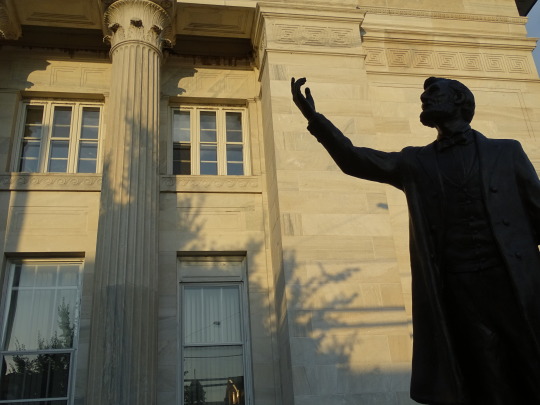



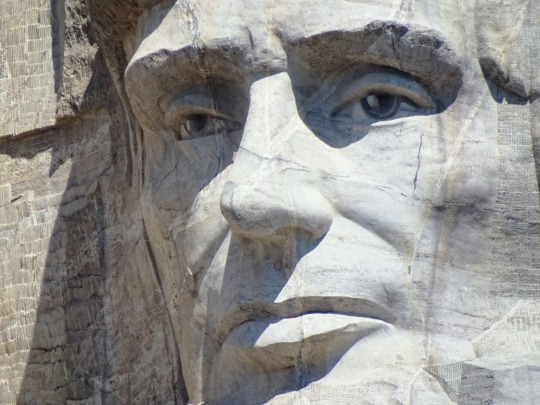

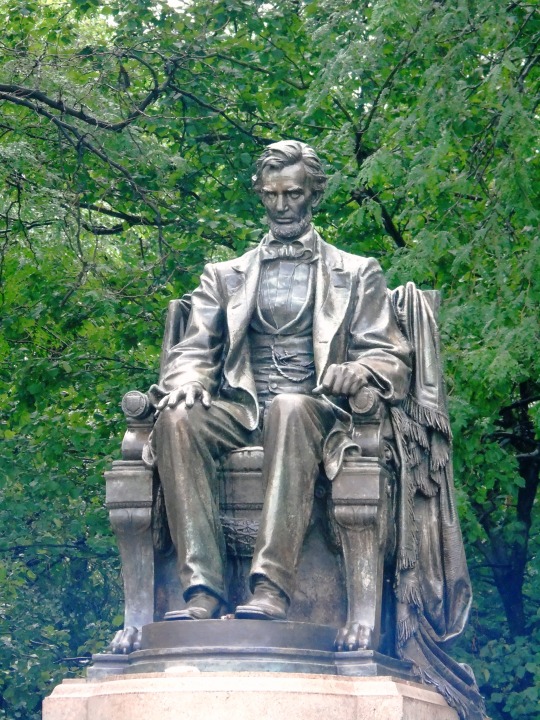

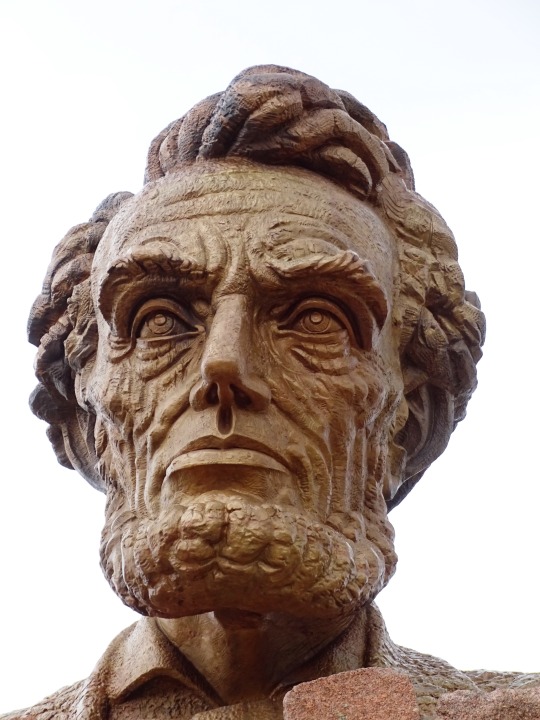

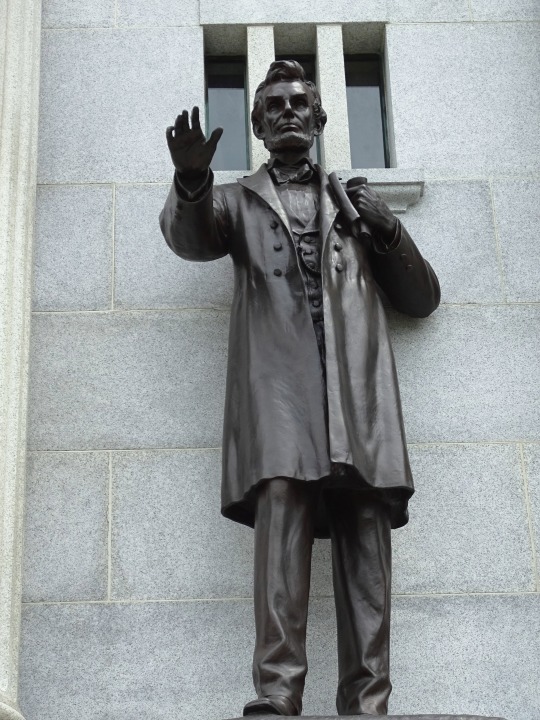

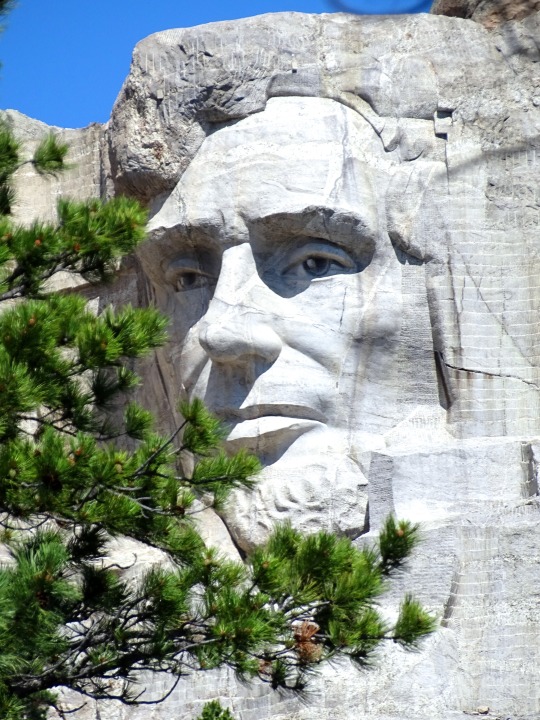



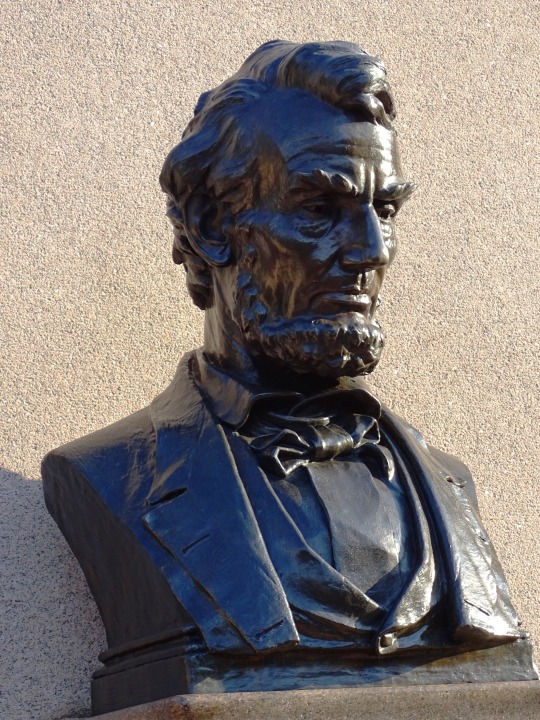

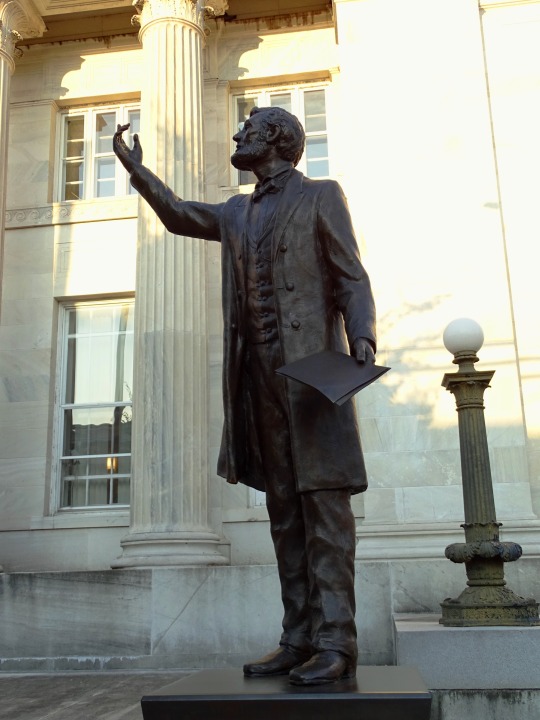

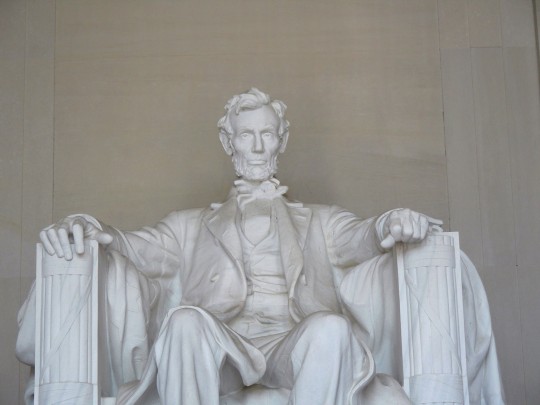

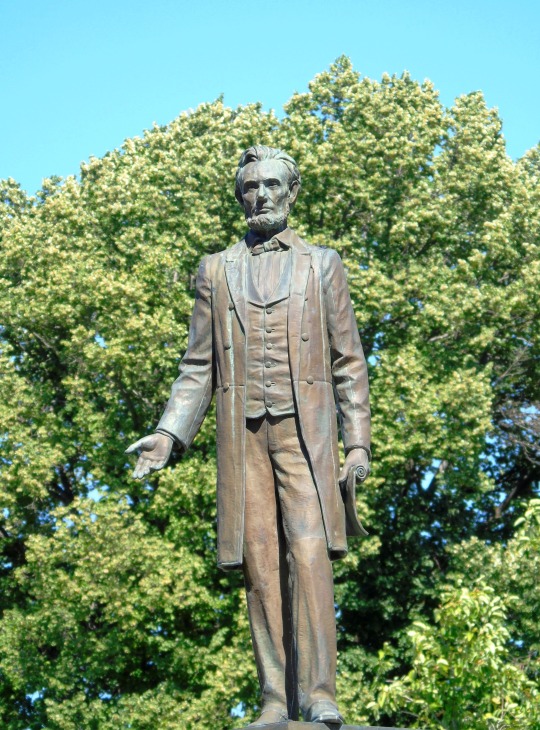
On February 27, 1860 Abraham Lincoln made a speech at Cooper Union in the city of New York that is largely responsible for his election to the Presidency. It is now referred to as the Cooper Union Address.
#The Cooper Union for the Advancement of Science and Art#Abraham Lincoln#speech#Cooper Union#Cooper Union Address#27 February 1860#USA#Manhattan#New York City#summer 2019#Cooper Union's Foundation Building#Italianate style#Fred A. Petersen#Stanley J. Watts#Gettysburg#travel#vacation#Mount Rushmore National Memorial#Gutzon Borglum#anniversary#US history#original photography#tourist attraction#cityscape#landmark#architecture
1 note
·
View note
Text
Lincoln at Cooper Union
This book by Harold Holzer looks at one of Abraham Lincoln’s most important speeches, the speech he gave at New York City’s Cooper Institute, known familiarly as Cooper Union, on February 27, 1860. Holzer makes the case for his labeling this speech as, “The Speech That Made Abraham Lincoln President. “One thing may be said with certainty. Had Lincoln failed at his nerve-wracking, physically…

View On WordPress
0 notes
Text





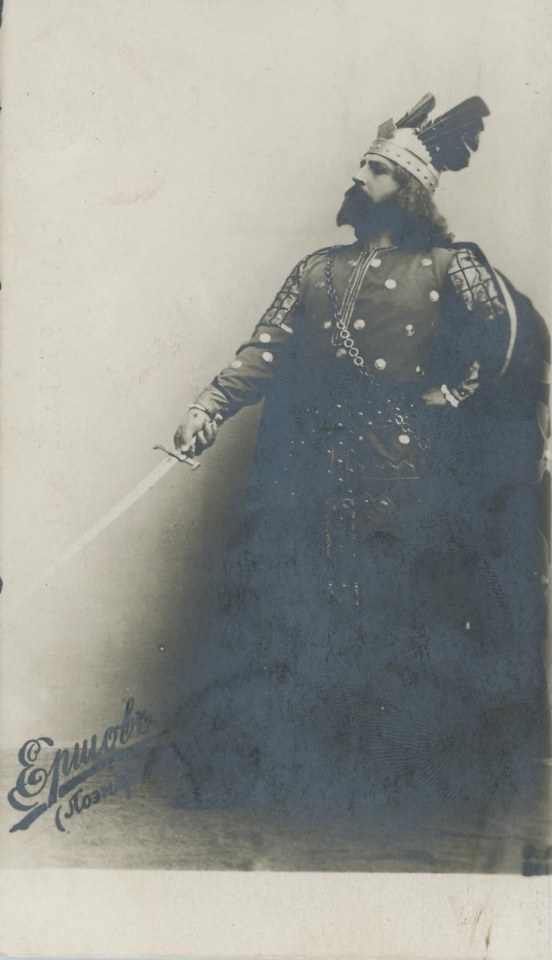

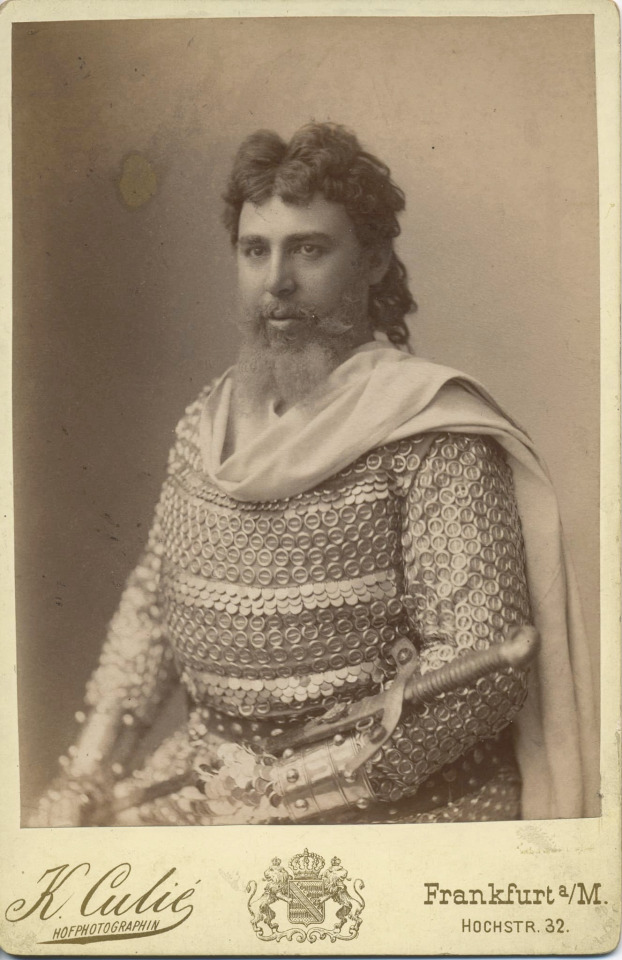



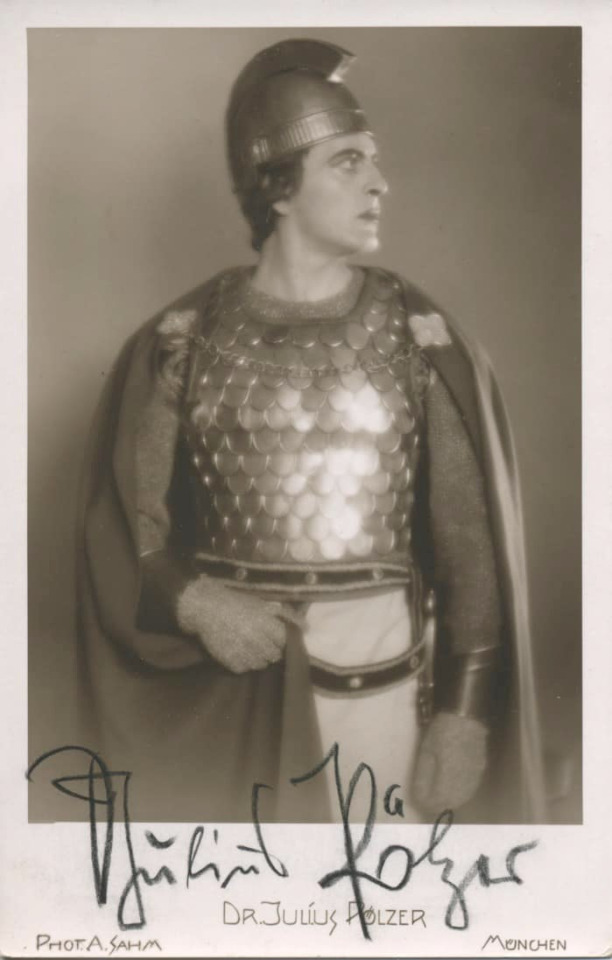

On June 10, 1865, the world premiere of "Tristan and Isolde" by R. Wagner took place in Munich.
„Isolde… wie schön…“
Here are some of the first tenors to have sung the role of Tristan over the years and contributed to the success of this work through their dedication.
Erik Schmedes (27 August 1868, in Gentofte, Denmark – 21 March 1931, in Vienna), Danish heldentenor.
Alois Pennarini (Vienna 1870 - Liberec, Czechoslovakia 1927), Austrian-Hungarian first spinto tenor then heldentenor.
Modest Menzinsky (29 April 1875 in Novosilky, Galicia - 11 December 1935 in Stockholm), Ukrainian heroic tenor.
Karl Kurz-Stolzenberg
Adolf Gröbke (May 26, 1872 Hildesheim - September 16, 1949 Epfach), German tenor.
Iwan Ershov (November 8, 1867 – November 21, 1943), Soviet and Russian dramatic tenor.
Alfred von Bary (January 18, 1873 in Valletta, Malta - September 13, 1926 in Munich), German tenor.
Alexander Bandrowsky (April 22, 1860 in Lubaczów - May 28, 1913 in Cracow), Polish Tenor.
Jacques Urlus (6 January 1867 in Hergenrath, Rhine Province – 6 June 1935 in Noordwijk, Netherlands), Dutch dramatic tenor.
Francesc Viñas (27 March 1863 – 14 July 1933), Spanish tenor.
Richard Schubert (Dessau, Germania; December 15, 1885 - Oberstaufen, Germania; October 12, 1959), German tenor.
Dr. Julius Pölzer (April 9, 1901 in Admont - February 16, 1972 in Vienna), Austrian tenor.
Giuseppe Borgatti (Cento, 17 March 1871 – Reno di Leggiuno, 18 October 1950), dramatic tenor. (with Magini-Coletti as Kurwenal)
Antonio Magini-Coletti (17 February 1855 – 21 July 1912), Italian baritone.
#opera#classical music#music history#bel canto#composer#classical composer#aria#tenor#classical studies#Tristan and Isolde#classical musician#classical musicians#musician#musicians#classical history#historian of music#history#maestro#chest voice#Tristan und Isolde#Richard Wagner#Wagner#classical singer#classical singing#opera history#music#classical
4 notes
·
View notes
Text
Jensen's folly and the proof of "No Irish Need Apply" [Part 2]
Continued from part 1. This post was originally published on WordPress in June 2018.
Looking on newspapers.com, I found 3,047,608 matches for the words "no Irish need apply," with even a story about it in the Buffalo paper, The Weekly Economist, in 1843. Now, not all of those portended to ads. [2] Narrowing the search, covering the years of 1800 to 1860, I brought the total to about 113,000. The latter number may be inflated due to false drops since quoting the phrase itself only brings up 158 results, extending it to 1900 gives you about 1,400 results, over 60 of which are listed below. I also got some sources from the Library of Congress's Chronicling America collection of old newspapers, which are included in the below listing of varied ads.
1820s
June 29, 1828 ad in the New York City paper, The Evening Post
July 24, 1828 ad in the New York City paper, The Evening Post
August 8, 1828 ad in the New York City paper, The Evening Post
September 11, 1828 ad in the New York City paper, The Evening Post
October 8, 1828 ad in the New York City paper, The Evening Post
June 8, 1829 ad in the New York City paper, The Evening Post
June 19, 1829 ad in the New York City paper, The Evening Post
June 23, 1829 ad in the New York City paper, The Evening Post
October 27, 1829 ad in the New York City paper, The Evening Post
1830s
April 29, 1830 ad in the New York City paper, The Evening Post, related to the one a few days before
New York Herald attacks No Irish Need Apply adverts on July 30, 1830
1840s
May 18, 1841 ad in the New York City paper, New York Tribune
August 24, 1842 ad in the New York City's New York Tribune
February 7, 1844 ad in the Philadelphia paper, Public Ledger
January 7, 1847 ad in the Philadelphia paper, Public Ledger
April 23, 1847 ad in the Philadelphia paper, Public Ledger
November 4, 1847 ad in the Philadelphia paper, Public Ledger
January 25, 1848 ad in the Philadelphia paper, Public Ledger
October 28, 1848 ad in the Philadelphia paper, Public Ledger
July 16, 1849 ad in the New York City paper, New York Herald, reprinted from days before
1850s
February 25, 1850 ad in the Philadelphia paper, Public Ledger
March 11, 1850 ad in the Philadelphia paper, Public Ledger
August 6, 1850 ad in the Philadelphia paper, Public Ledger
January 13, 1851 ad in the New York City's New York Tribune
February 5, 1851 ad in the Baltimore Sun
March 13, 1851 ad in the New York Daily Herald
April 22, 1851 ad in the Baltimore Sun
July 24, 1851 ad in the Philadelphia paper, Public Ledger
December 31, 1851 ad in the Baltimore Sun, accompanied by another saying they are looking for someone who is white, but not Irish, as a cook
April 13, 1852 ads (top and bottom of image) in the Philadelphia paper, Public Ledger
May 14, 1852 ad in New York City's New York Tribune
June 21, 1852 ad in the Philadelphia paper, Public Ledger
August 26, 1852 ad in the Philadelphia paper, Public Ledger
October 11, 1852 ad in the Philadelphia paper, Public Ledger
December 31, 1852 ad in the New Orleans paper, The Times-Picayune
June 22, 1853, the Lancaster Ledger reports that the New York Herald is being sued for libel for attaching "no Irish may apply" to one of its ads, which the Ledger calls "queer"
June 2, 1853, the New York Herald criticizes "No Irish Need Apply" ads
July 30, 1853 ad in the Philadelphia paper, Public Ledger
February 19, 1854, the New York Herald talks about their ""No Irish Need Apply" advertisers"
March 30, 1854 ad in the Baltimore Sun
October 6, 1854 ad in the West Virginia paper, the Wheeling Daily Intelligencer
April 21, 1855 ad in the Freehold, New Jersey paper, the Monmouth Inquirer
May 18, 1855 ad in Baltimore Sun
September 18, 1855 ad in the Philadelphia paper, Public Ledger
October 17, 1855 ad in the Washington, D.C. Evening Star, likely related.
March 28, 1856 ad in the Baltimore Sun
February 14, 1857 ad in the New York Times
December 7, 1857 ad in New Orleans paper, The Times-Picayune
April 20, 1857 ad in the Baltimore Sun
March 20, 1858 ad in the New York Times
August 17, 1858 ad in the Baltimore Sun
October 1, 1858 ad in the Baltimore Sun, reprinted on October 2 and 4, at least
October 13, 1858 ad in New York Times
May 10, 1859 ad in the New York Times
September 21, 1859 ad in the New York Times
1860s
March 29, 1860 ad in the Brooklyn Daily Eagle
April 3, 1860 ads (here and here) in the Philadelphia paper, Public Ledger
June 8, 1860 ad in the Baltimore Sun, related is ad the day before
August 6, 1860 ad in the Cincinnati Daily Press
August 25, 1860 ad in the Philadelphia paper, Public Ledger
Ad and comment in Columbia Democrat and Bloomsburg General Advertiser (Bloomsburg, Pennsylvania) on March 12, 1864
© 2018-2023 Burkely Hermann. All rights reserved.
Notes
[2] This is apart from mentions of it in 1878 to counter such sentiment (and in 1864), the Guardian (see here, here, here, and here), the Liverpool Mercury in 1854 (here and here), 1855 (also see here, here, here, ), 1857, 1858, 1859, and 1863, along with other mentions in English papers in 1844, 1847, and 1856. A comedy, in the 1850s, was even produced on this subject! In all, there are over 105,000 results for England alone, over 9,000 for Scotland, over 8,000 for Ireland, over 5,000 for Northern Ireland, over 4,700 for Australia, over 1,500 for Wales and almost 1,000 for Canada.
#irish history#irish americans#irish heritage#irish genealogy#newspaper clippings#1860s#1850s#1840s#1830s#1820s#wordpress#19th century
0 notes
Text
June 17, 1854
The Republican Party is officially founded as an abolitionist party to slavery in the United States.
October 13, 1858
During the Lincoln-Douglas debates, U.S. Senator Stephen Douglas (D-IL) said, “If you desire negro citizenship, if you desire to allow them to come into the State and settle with the white man, if you desire them to vote on an equality with yourselves, and to make them eligible to office, to serve on juries, and to adjudge your rights, then support Mr. Lincoln and the Black Republican party, who are in favor of the citizenship of the negro. For one, I am opposed to negro citizenship in any and every form. I believe this Government was made on the white basis. I believe it was made by white men for the benefit of white men and their posterity for ever, and I am in favor of confining citizenship to white men, men of European birth and descent, instead of conferring it upon negroes, Indians, and other inferior races.”. Douglas became the Democrat Party’s 1860 presidential nominee.
April 16, 1862
President Lincoln signed the bill abolishing slavery in the District of Columbia. In Congress, almost every Republican voted for yes and most Democrats voted no.
July 17, 1862
Over unanimous Democrat opposition, the Republican Congress passed The Confiscation Act stating that slaves of the Confederacy “shall be forever free”.
April 8, 1864
The 13th Amendment banning slavery passed the U.S. Senate with 100% Republican support, 63% Democrat opposition.
January 31, 1865
The 13th Amendment banning slavery passed the U.S. House with unanimous Republican support and intense Democrat opposition.November 22, 1865
Republicans denounced the Democrat legislature of Mississippi for enacting the “black codes” which institutionalized racial discrimination.
February 5, 1866
U.S. Rep. Thaddeus Stevens (R-PA) introduced legislation (successfully opposed by Democrat President Andrew Johnson) to implement “40 acres and a mule” relief by distributing land to former slaves.
March 27, 1866
Democrat President Andrew Johnson vetoes of law granting voting rights to blacks.
May 10, 1866
The U.S. House passed the Republicans’ 14th Amendment guaranteeing due process and equal protection of the laws to all citizens. 100% of Democrats vote no.
June 8, 1866
The U.S. Senate passed the Republicans’ 14th Amendment guaranteeing due process and equal protection of the law to all citizens. 94% of Republicans vote yes and 100% of Democrats vote no.
March 27, 1866
Democrat President Andrew Johnson vetoes of law granting voting rights to blacks in the District of Columbia.
July 16, 1866
The Republican Congress overrode Democrat President Andrew Johnson’s veto of legislation protecting the voting rights of blacks.
March 30, 1868
Republicans begin the impeachment trial of Democrat President Andrew Johnson who declared, “This is a country for white men, and by God, as long as I am President, it shall be a government of white men.”September 12, 1868
Civil rights activist Tunis Campbell and 24 other blacks in the Georgia Senate (all Republicans) were expelled by the Democrat majority and would later be reinstated by the Republican Congress.
October 7, 1868
Republicans denounced Democrat Party’s national campaign theme: “This is a white man’s country: Let white men rule.”
October 22, 1868
While campaigning for re-election, Republican U.S. Rep. James Hinds (R-AR) was assassinated by Democrat terrorists who organized as the Ku Klux Klan. Hinds was the first sitting congressman to be murdered while in office.
December 10, 1869
Republican Gov. John Campbell of the Wyoming Territory signed the FIRST-in-nation law granting women the right to vote and hold public office.
February 3, 1870
After passing the House with 98% Republican support and 97% Democrat opposition, Republicans’ 15th Amendment was ratified, granting the vote to ALL Americans regardless of race.
February 25, 1870
Hiram Rhodes Revels (R-MS) becomes the first black to be seated in the United States Senate.
May 31, 1870
President U.S. Grant signed the Republicans’ Enforcement Act providing stiff penalties for depriving any American’s civil rights.
June 22, 1870
Ohio Rep. Williams Lawrence created the U.S. Department of Justice to safeguard the civil rights of blacks against Democrats in the South.
September 6, 1870
Women voted in Wyoming in first election after women’s suffrage signed into law by Republican Gov. John Campbell.
February 1, 1871
Rep. Jefferson Franklin Long (R-GA) became the first black to speak on the floor of the U.S. House of Representatives.
February 28, 1871
The Republican Congress passed the Civil Rights Act of 1871 providing federal protection for black voters.
April 20, 1871
The Republican Congress enacted the Ku Klux Klan Act, outlawing Democrat Party-affiliated terrorist groups which oppressed blacks and all those who supported them.
October 10, 1871
Following warnings by Philadelphia Democrats against black voting, Republican civil rights activist Octavius Catto was murdered by a Democrat Party operative. His military funeral was attended by thousands.
October 18, 1871
After violence against Republicans in South Carolina, President Ulysses Grant deployed U.S. troops to combat Democrat Ku Klux Klan terrorists.
November 18, 1872
Susan B. Anthony was arrested for voting after boasting to Elizabeth Cady Stanton that she voted for “Well, I have gone and done it — positively voted the straight Republican ticket.”January 17, 1874
Armed Democrats seized the Texas state government, ending Republican efforts to racially integrate.
September 14, 1874
Democrat white supremacists seized the Louisiana statehouse in attempt to overthrow the racially-integrated administration of Republican Governor William Kellogg. Twenty-seven were killed.
March 1, 1875
The Civil Rights Act of 1875, guaranteeing access to public accommodations without regard to race, was signed by Republican President U.S. Grant and passed with 92% Republican support over 100% Democrat opposition.
January 10, 1878
U.S. Senator Aaron Sargent (R-CA) introduced the Susan B. Anthony amendment for women’s suffrage. The Democrat-controlled Senate defeated it four times before the election of a Republican House and Senate that guaranteed its approval in 1919.
February 8, 1894
The Democrat Congress and Democrat President Grover Cleveland joined to repeal the Republicans’ Enforcement Act which had enabled blacks to vote.
January 15, 1901
Republican Booker T. Washington protested the Alabama Democrat Party’s refusal to permit voting by blacks.
May 29, 1902
Virginia Democrats implemented a new state constitution condemned by Republicans as illegal, reducing black voter registration by almost 90%.
February 12, 1909
On the 100th anniversary of Abraham Lincoln’s birth, black Republicans and women’s suffragists Ida Wells and Mary Terrell co-founded the National Association for the Advancement of Colored People.
May 21, 1919
The Republican House passed a constitutional amendment granting women the vote with 85% of Republicans and only 54% of Democrats in favor. In the Senate 80% of Republicans voted yes and almost half of Democrats voted no.
August 18, 1920
The Republican-authored 19th Amendment giving women the right to vote became part of the Constitution. Twenty-six of the 36 states needed to ratify had Republican-controlled legislatures.
January 26, 1922
The House passed a bill authored by U.S. Rep. Leonidas Dyer (R-MO) making lynching a federal crime. Senate Democrats blocked it by filibuster.
June 2, 1924
Republican President Calvin Coolidge signed a bill passed by the Republican Congress granting U.S. citizenship to all Native Americans.
October 3, 1924
Republicans denounced three-time Democrat presidential nominee William Jennings Bryan for defending the Ku Klux Klan at the 1924 Democratic National Convention.
June 12, 1929
First Lady Lou Hoover invited the wife of black Rep. Oscar De Priest (R-IL) to tea at the White House, sparking protests by Democrats across the country.
August 17, 1937
Republicans organized opposition to former Ku Klux Klansman and Democrat U.S. Senator Hugo Black who was later appointed to the U.S. Supreme Court by FDR. Black’s Klan background was hidden until after confirmation.
June 24, 1940
The Republican Party platform called for the integration of the Armed Forces. For the balance of his terms in office, President Franklin Delano Roosevelt (D) refused to order it.
August 8, 1945
Republicans condemned Harry Truman’s surprise use of the atomic bomb in Japan. It began two days after the Hiroshima bombing when former Republican President Herbert Hoover wrote that “The use of the atomic bomb, with its indiscriminate killing of women and children, revolts my soul.”
May 17, 1954
Earl Warren, California’s three-term Republican Governor and 1948 Republican vice presidential nominee, was nominated to be Chief Justice delivered the landmark decision “Brown v. Board of Education”.
November 25, 1955
Republican President Dwight D. Eisenhower’s administration banned racial segregation of interstate bus travel.
March 12, 1956
Ninety-seven Democrats in Congress condemned the Supreme Court’s “Brown v. Board of Education” decision and pledged (Southern Manifesto) to continue segregation.
June 5, 1956
Republican federal judge Frank Johnson ruled in favor of the Rosa Parks decision striking down the “blacks in the back of the bus” law.
November 6, 1956
African-American civil rights leaders Martin Luther King and Ralph Abernathy voted for Republican Dwight Eisenhower for President.
September 9, 1957
President Eisenhower signed the Republican Party’s 1957 Civil Rights Act.
September 24, 1957
Sparking criticism from Democrats such as Senators John Kennedy and Lyndon Johnson, President Eisenhower deployed the 82nd Airborne Division to Little Rock, AR to force Democrat Governor Orval Faubus to integrate their public schools.
May 6, 1960
President Eisenhower signed the Republicans’ Civil Rights Act of 1960, overcoming a 125-hour, ’round-the-clock filibuster by 18 Senate Democrats.
May 2, 1963
Republicans condemned Bull Connor, the Democrat “Commissioner of Public Safety” in Birmingham, AL for arresting over 2,000 black schoolchildren marching for their civil rights.
September 29, 1963
Gov. George Wallace (D-AL) defied an order by U.S. District Judge Frank Johnson (appointed by President Dwight Eisenhower) to integrate Tuskegee High School.
June 9, 1964
Republicans condemned the 14-hour filibuster against the 1964 Civil Rights Act by U.S. Senator and former Ku Klux Klansman Robert Byrd (D-WV), who served in the Senate until his death in 2010.
June 10, 1964
Senate Minority Leader Everett Dirksen (R-IL) criticized the Democrat filibuster against 1964 Civil Rights Act and called on Democrats to stop opposing racial equality. The Civil Rights Act of 1964 was introduced and approved by a majority of Republicans in the Senate. The Act was opposed by most southern Democrat senators, several of whom were proud segregationists — one of them being Al Gore Sr. (D). President Lyndon B. Johnson relied on Illinois Senator Everett Dirksen, the Republican leader from Illinois, to get the Act passed.
August 4, 1965
Senate Leader Everett Dirksen (R-IL) overcame Democrat attempts to block 1965 Voting Rights Act. Ninety-four percent of Republicans voted for the landmark civil rights legislation while 27% of Democrats opposed. The Voting Rights Act of 1965, abolishing literacy tests and other measures devised by Democrats to prevent blacks from voting, was signed into law. A higher percentage of Republicans voted in favor.
February 19, 1976
President Gerald Ford formally rescinded President Franklin D. Roosevelt’s notorious Executive Order 9066 authorizing the internment of over 120,000 Japanese-Americans during WWII.
September 15, 1981
President Ronald Reagan established the White House Initiative on Historically Black Colleges and Universities to increase black participation in federal education programs.
June 29, 1982
President Ronald Reagan signed a 25-year extension of the 1965 Voting Rights Act.
August 10, 1988
President Ronald Reagan signed the Civil Liberties Act of 1988, compensating Japanese-Americans for the deprivation of their civil rights and property during the World War II internment ordered by FDR.
November 21, 1991
President George H. W. Bush signed the Civil Rights Act of 1991 to strengthen federal civil rights legislation.
August 20, 1996
A bill authored by U.S. Rep. Susan Molinari (R-NY) to prohibit racial discrimination in adoptions, part of Republicans’ “Contract With America”, became law.
July 2, 2010
Clinton says Byrd joined KKK to help him get elected
Just a “fleeting association”. Nothing to see here.
Only a willing fool (and there quite a lot out there) would accept and recite the nonsensical that one bright, sunny day Democrats and Republicans just up and decided to “switch” political positions and cite the “Southern Strategy” as the uniform knee-jerk retort. Even today, it never takes long for a Democrat to play the race card purely for political advantage.Thanks to the Democrat Party, blacks have the distinction of being the only group in the United States whose history is a work-in-progress.
The idea that “the Dixiecrats joined the Republicans” is not quite true, as you note. But because of Strom Thurmond it is accepted as a fact. What happened is that the **next** generation (post 1965) of white southern politicians — Newt, Trent Lott, Ashcroft, Cochran, Alexander, etc — joined the GOP.So it was really a passing of the torch as the old segregationists retired and were replaced by new young GOP guys. One particularly galling aspect to generalizations about “segregationists became GOP” is that the new GOP South was INTEGRATED for crying out loud, they accepted the Civil Rights revolution. Meanwhile, Jimmy Carter led a group of what would become “New” Democrats like Clinton and Al Gore.
There weren’t many Republicans in the South prior to 1964, but that doesn’t mean the birth of the southern GOP was tied to “white racism.” That said, I am sure there were and are white racist southern GOP. No one would deny that. But it was the southern Democrats who were the party of slavery and, later, segregation. It was George Wallace, not John Tower, who stood in the southern schoolhouse door to block desegregation! The vast majority of Congressional GOP voted FOR the Civil Rights of 1964-65. The vast majority of those opposed to those acts were southern Democrats. Southern Democrats led to infamous filibuster of the 1964 Civil Rights Act.The confusion arises from GOP Barry Goldwater’s vote against the ’64 act. He had voted in favor or all earlier bills and had led the integration of the Arizona Air National Guard, but he didn’t like the “private property” aspects of the ’64 law. In other words, Goldwater believed people’s private businesses and private clubs were subject only to market forces, not government mandates (“We reserve the right to refuse service to anyone.”) His vote against the Civil Rights Act was because of that one provision was, to my mind, a principled mistake.This stance is what won Goldwater the South in 1964, and no doubt many racists voted for Goldwater in the mistaken belief that he opposed Negro Civil Rights. But Goldwater was not a racist; he was a libertarian who favored both civil rights and property rights.Switch to 1968.Richard Nixon was also a proponent of Civil Rights; it was a CA colleague who urged Ike to appoint Warren to the Supreme Court; he was a supporter of Brown v. Board, and favored sending troops to integrate Little Rock High). Nixon saw he could develop a “Southern strategy” based on Goldwater’s inroads. He did, but Independent Democrat George Wallace carried most of the deep south in 68. By 1972, however, Wallace was shot and paralyzed, and Nixon began to tilt the south to the GOP. The old guard Democrats began to fade away while a new generation of Southern politicians became Republicans. True, Strom Thurmond switched to GOP, but most of the old timers (Fulbright, Gore, Wallace, Byrd etc etc) retired as Dems.Why did a new generation white Southerners join the GOP? Not because they thought Republicans were racists who would return the South to segregation, but because the GOP was a “local government, small government” party in the old Jeffersonian tradition. Southerners wanted less government and the GOP was their natural home.Jimmy Carter, a Civil Rights Democrat, briefly returned some states to the Democrat fold, but in 1980, Goldwater’s heir, Ronald Reagan, sealed this deal for the GOP. The new “Solid South” was solid GOP.BUT, and we must stress this: the new southern Republicans were *integrationist* Republicans who accepted the Civil Rights revolution and full integration while retaining their love of Jeffersonian limited government principles.
Oh wait, princess, I am not done yet.
Where Teddy Roosevelt invited Booker T. Washington to dinner, Woodrow Wilson re-segregated the U.S. government and had the pro-Klan film “Birth of a Nation” screened in his White House.
Wilson and FDR carried all 11 states of the Old Confederacy all six times they ran, when Southern blacks had no vote. Disfranchised black folks did not seem to bother these greatest of liberal icons.
As vice president, FDR chose “Cactus Jack” Garner of Texas who played a major role in imposing a poll tax to keep blacks from voting.
Among FDR’s Supreme Court appointments was Hugo Black, a Klansman who claimed FDR knew this when he named him in 1937 and that FDR told him that “some of his best friends” in Georgia were Klansmen.
Black’s great achievement as a lawyer was in winning acquittal of a man who shot to death the Catholic priest who had presided over his daughter’s marriage to a Puerto Rican.
In 1941, FDR named South Carolina Sen. “Jimmy” Byrnes to the Supreme Court. Byrnes had led filibusters in 1935 and 1938 that killed anti-lynching bills, arguing that lynching was necessary “to hold in check the Negro in the South.”
FDR refused to back the 1938 anti-lynching law.
“This is a white man’s country and will always remain a white man’s country,” said Jimmy. Harry Truman, who paid $10 to join the Klan, then quit, named Byrnes Secretary of State, putting him first in line of succession to the presidency, as Harry then had no V.P.
During the civil rights struggles of the ‘50s and ‘60s, Gov. Orval Faubus used the National Guard to keep black students out of Little Rock High. Gov. Ross Barnett refused to let James Meredith into Ole Miss. Gov. George Wallace stood in the door at the University of Alabama, to block two black students from entering.
All three governors were Democrats. All acted in accord with the “Dixie Manifesto” of 1956, which was signed by 19 senators, all Democrats, and 80 Democratic congressmen.
Among the signers of the manifesto, which called for massive resistance to the Brown decision desegregating public schools, was the vice presidential nominee on Adlai’s Stevenson’s ticket in 1952, Sen. John Sparkman of Alabama.
Though crushed by Eisenhower, Adlai swept the Deep South, winning both Carolinas, Georgia, Alabama, Mississippi, Louisiana and Arkansas.
Do you suppose those Southerners thought Adlai would be tougher than Ike on Stalin? Or did they think Adlai would maintain the unholy alliance of Southern segregationists and Northern liberals that enabled Democrats to rule from 1932 to 1952?
The Democratic Party was the party of slavery, secession and segregation, of “Pitchfork Ben” Tillman and the KKK. “Bull” Connor, who turned the dogs loose on black demonstrators in Birmingham, was the Democratic National Committeeman from Alabama.
And Nixon?
In 1956, as vice president, Nixon went to Harlem to declare, “America can’t afford the cost of segregation.” The following year, Nixon got a personal letter from Dr. King thanking him for helping to persuade the Senate to pass the Civil Rights Act of 1957.
Nixon supported the civil rights acts of 1964, 1965 and 1968.
In the 1966 campaign, as related in my new book “The Greatest Comeback: How Richard Nixon Rose From Defeat to Create the New Majority,” out July 8, Nixon blasted Dixiecrats “seeking to squeeze the last ounces of political juice out of the rotting fruit of racial injustice.”
Nixon called out segregationist candidates in ‘66 and called on LBJ, Hubert Humphrey and Bobby Kennedy to join him in repudiating them. None did. Hubert, an arm around Lester Maddox, called him a “good Democrat.” And so were they all – good Democrats.
While Adlai chose Sparkman, Nixon chose Spiro Agnew, the first governor south of the Mason Dixon Line to enact an open-housing law.
In Nixon’s presidency, the civil rights enforcement budget rose 800 percent. Record numbers of blacks were appointed to federal office. An Office of Minority Business Enterprise was created. SBA loans to minorities soared 1,000 percent. Aid to black colleges doubled.
Nixon won the South not because he agreed with them on civil rights – he never did – but because he shared the patriotic values of the South and its antipathy to liberal hypocrisy.
When Johnson left office, 10 percent of Southern schools were desegregated.
When Nixon left, the figure was 70 percent. Richard Nixon desegregated the Southern schools, something you won’t learn in today’s public schools.
Not done there yet, snowflake.
1964:George Romney, Republican civil rights activist. That Republicans have let Democrats get away with this mountebankery is a symptom of their political fecklessness, and in letting them get away with it the GOP has allowed itself to be cut off rhetorically from a pantheon of Republican political heroes, from Abraham Lincoln and Frederick Douglass to Susan B. Anthony, who represent an expression of conservative ideals as true and relevant today as it was in the 19th century.
Perhaps even worse, the Democrats have been allowed to rhetorically bury their Bull Connors, their longstanding affiliation with the Ku Klux Klan, and their pitiless opposition to practically every major piece of civil-rights legislation for a century.
Republicans may not be able to make significant inroads among black voters in the coming elections, but they would do well to demolish this myth nonetheless.
Even if the Republicans’ rise in the South had happened suddenly in the 1960s (it didn’t) and even if there were no competing explanation (there is), racism — or, more precisely, white southern resentment over the political successes of the civil-rights movement — would be an implausible explanation for the dissolution of the Democratic bloc in the old Confederacy and the emergence of a Republican stronghold there.
That is because those southerners who defected from the Democratic Party in the 1960s and thereafter did so to join a Republican Party that was far more enlightened on racial issues than were the Democrats of the era, and had been for a century.
There is no radical break in the Republicans’ civil-rights history: From abolition to Reconstruction to the anti-lynching laws, from the Fourteenth and Fifteenth Amendments to the Civil Rights Act of 1875 to the Civil Rights Acts of 1957, 1960, and 1964, there exists a line that is by no means perfectly straight or unwavering but that nonetheless connects the politics of Lincoln with those of Dwight D. Eisenhower.
And from slavery and secession to remorseless opposition to everything from Reconstruction to the anti-lynching laws, the Fourteenth and Fifteenth Amendments, the Civil Rights Act of 1875, and the Civil Rights Acts of 1957 and 1960, there exists a similarly identifiable line connecting John Calhoun and Lyndon Baines Johnson.
Supporting civil-rights reform was not a radical turnaround for congressional Republicans in 1964, but it was a radical turnaround for Johnson and the Democrats.
The depth of Johnson’s prior opposition to civil-rights reform must be digested in some detail to be properly appreciated.
In the House, he did not represent a particularly segregationist constituency (it “made up for being less intensely segregationist than the rest of the South by being more intensely anti-Communist,” as the New York Times put it), but Johnson was practically antebellum in his views.
Never mind civil rights or voting rights: In Congress, Johnson had consistently and repeatedly voted against legislation to protect black Americans from lynching.
As a leader in the Senate, Johnson did his best to cripple the Civil Rights Act of 1957; not having votes sufficient to stop it, he managed to reduce it to an act of mere symbolism by excising the enforcement provisions before sending it to the desk of President Eisenhower.
Johnson’s Democratic colleague Strom Thurmond nonetheless went to the trouble of staging the longest filibuster in history up to that point, speaking for 24 hours in a futile attempt to block the bill.
The reformers came back in 1960 with an act to remedy the deficiencies of the 1957 act, and Johnson’s Senate Democrats again staged a record-setting filibuster.
In both cases, the “master of the Senate” petitioned the northeastern Kennedy liberals to credit him for having seen to the law’s passage while at the same time boasting to southern Democrats that he had taken the teeth out of the legislation.
Johnson would later explain his thinking thus: “These Negroes, they’re getting pretty uppity these days, and that’s a problem for us, since they’ve got something now they never had before: the political pull to back up their uppityness. Now we’ve got to do something about this — we’ve got to give them a little something, just enough to quiet them down, not enough to make a difference.”
Johnson did not spring up from the Democratic soil ex nihilo.
Not one Democrat in Congress voted for the Fourteenth Amendment.
Not one Democrat in Congress voted for the Fifteenth Amendment.
Not one voted for the Civil Rights Act of 1875.
Dwight Eisenhower as a general began the process of desegregating the military, and Truman as president formalized it, but the main reason either had to act was that President Woodrow Wilson, the personification of Democratic progressivism, had resegregated previously integrated federal facilities. (“If the colored people made a mistake in voting for me, they ought to correct it,” he declared.)
Klansmen from Senator Robert Byrd to Justice Hugo Black held prominent positions in the Democratic Party — and President Wilson chose the Klan epic Birth of a Nation to be the first film ever shown at the White House.
Johnson himself denounced an earlier attempt at civil-rights reform as the “nigger bill.” So what happened in 1964 to change Democrats’ minds? In fact, nothing.
President Johnson was nothing if not shrewd, and he knew something that very few popular political commentators appreciate today: The Democrats began losing the “solid South” in the late 1930s — at the same time as they were picking up votes from northern blacks.
The Civil War and the sting of Reconstruction had indeed produced a political monopoly for southern Democrats that lasted for decades, but the New Deal had been polarizing. It was very popular in much of the country, including much of the South — Johnson owed his election to the House to his New Deal platform and Roosevelt connections — but there was a conservative backlash against it, and that backlash eventually drove New Deal critics to the Republican Party.
Likewise, adherents of the isolationist tendency in American politics, which is never very far from the surface, looked askance at what Bob Dole would later famously call “Democrat wars” (a factor that would become especially relevant when the Democrats under Kennedy and Johnson committed the United States to a very divisive war in Vietnam).
The tiniest cracks in the Democrats’ southern bloc began to appear with the backlash to FDR’s court-packing scheme and the recession of 1937.
Republicans would pick up 81 House seats in the 1938 election, with West Virginia’s all-Democrat delegation ceasing to be so with the acquisition of its first Republican.
Kentucky elected a Republican House member in 1934, as did Missouri, while Tennessee’s first Republican House member, elected in 1918, was joined by another in 1932.
Throughout the 1940s and 1950s, the Republican Party, though marginal, began to take hold in the South — but not very quickly: Dixie would not send its first Republican to the Senate until 1961, with Texas’s election of John Tower.
At the same time, Republicans went through a long dry spell on civil-rights progress.
Many of them believed, wrongly, that the issue had been more or less resolved by the constitutional amendments that had been enacted to ensure the full citizenship of black Americans after the Civil War, and that the enduring marginalization of black citizens, particularly in the Democratic states, was a problem that would be healed by time, economic development, and organic social change rather than through a second political confrontation between North and South.
As late as 1964, the Republican platform argued that “the elimination of any such discrimination is a matter of heart, conscience, and education, as well as of equal rights under law.”
The conventional Republican wisdom of the day held that the South was backward because it was poor rather than poor because it was backward.
And their strongest piece of evidence for that belief was that Republican support in the South was not among poor whites or the old elites — the two groups that tended to hold the most retrograde beliefs on race.
Instead, it was among the emerging southern middle class.
This fact was recently documented by professors Byron Shafer and Richard Johnston in The End of Southern Exceptionalism: Class, Race, and Partisan Change in the Postwar South (Harvard University Press, 2006).
Which is to say: The Republican rise in the South was contemporaneous with the decline of race as the most important political question and tracked the rise of middle-class voters moved mainly by economic considerations and anti-Communism.
The South had been in effect a Third World country within the United States, and that changed with the post-war economic boom.
As Clay Risen put it in the New York Times: “The South transformed itself from a backward region to an engine of the national economy, giving rise to a sizable new wealthy suburban class.
This class, not surprisingly, began to vote for the party that best represented its economic interests: the GOP. Working-class whites, however — and here’s the surprise — even those in areas with large black populations, stayed loyal to the Democrats.
This was true until the 90s, when the nation as a whole turned rightward in Congressional voting.” The mythmakers would have you believe that it was the opposite: that your white-hooded hillbilly trailer-dwelling tornado-bait voters jumped ship because LBJ signed a civil-rights bill (passed on the strength of disproportionately Republican support in Congress). The facts suggest otherwise. There is no question that Republicans in the 1960s and thereafter hoped to pick up the angry populists who had delivered several states to Wallace.
That was Patrick J. Buchanan’s portfolio in the Nixon campaign.
But in the main they did not do so by appeal to racial resentment, direct or indirect.
The conservative ascendency of 1964 saw the nomination of Barry Goldwater, a western libertarian who had never been strongly identified with racial issues one way or the other, but who was a principled critic of the 1964 act and its extension of federal power.
Goldwater had supported the 1957 and 1960 acts but believed that Title II and Title VII of the 1964 bill were unconstitutional, based in part on a 75-page brief from Robert Bork.
But far from extending a welcoming hand to southern segregationists, he named as his running mate a New York representative, William E. Miller, who had been the co-author of Republican civil-rights legislation in the 1950s.
The Republican platform in 1964 was hardly catnip for Klansmen: It spoke of the Johnson administration’s failure to help further the “just aspirations of the minority groups” and blasted the president for his refusal “to apply Republican-initiated retraining programs where most needed, particularly where they could afford new economic opportunities to Negro citizens.”
Other planks in the platform included: “improvements of civil rights statutes adequate to changing needs of our times; such additional administrative or legislative actions as may be required to end the denial, for whatever unlawful reason, of the right to vote; continued opposition to discrimination based on race, creed, national origin or sex.”
And Goldwater’s fellow Republicans ran on a 1964 platform demanding “full implementation and faithful execution of the Civil Rights Act of 1964, and all other civil rights statutes, to assure equal rights and opportunities guaranteed by the Constitution to every citizen.” Some dog whistle.
Of course there were racists in the Republican Party. There were racists in the Democratic Party. The case of Johnson is well documented, while Nixon had his fantastical panoply of racial obsessions, touching blacks, Jews, Italians (“Don’t have their heads screwed on”), Irish (“They get mean when they drink”), and the Ivy League WASPs he hated so passionately (“Did one of those dirty bastards ever invite me to his f***ing men’s club or goddamn country club? Not once”).
But the legislative record, the evolution of the electorate, the party platforms, the keynote speeches — none of them suggests a party-wide Republican about-face on civil rights.
Neither does the history of the black vote.
While Republican affiliation was beginning to grow in the South in the late 1930s, the GOP also lost its lock on black voters in the North, among whom the New Deal was extraordinarily popular.
By 1940, Democrats for the first time won a majority of black votes in the North. This development was not lost on Lyndon Johnson, who crafted his Great Society with the goal of exploiting widespread dependency for the benefit of the Democratic Party.
Unlike the New Deal, a flawed program that at least had the excuse of relying upon ideas that were at the time largely untested and enacted in the face of a worldwide economic emergency, Johnson’s Great Society was pure politics.
Johnson’s War on Poverty was declared at a time when poverty had been declining for decades, and the first Job Corps office opened when the unemployment rate was less than 5 percent.
Congressional Republicans had long supported a program to assist the indigent elderly, but the Democrats insisted that the program cover all of the elderly — even though they were, then as now, the most affluent demographic, with 85 percent of them in households of above-average wealth.
Democrats such as Secretary of Health, Education, and Welfare Anthony J. Celebrezze argued that the Great Society would end “dependency” among the elderly and the poor, but the programs were transparently designed merely to transfer dependency from private and local sources of support to federal agencies created and overseen by Johnson and his political heirs.
In the context of the rest of his program, Johnson’s unexpected civil-rights conversion looks less like an attempt to empower blacks and more like an attempt to make clients of them.
If the parties had in some meaningful way flipped on civil rights, one would expect that to show up in the electoral results in the years following the Democrats’ 1964 about-face on the issue.
Nothing of the sort happened: Of the 21 Democratic senators who opposed the 1964 act, only one would ever change parties.
Nor did the segregationist constituencies that elected these Democrats throw them out in favor of Republicans: The remaining 20 continued to be elected as Democrats or were replaced by Democrats.
It was, on average, nearly a quarter of a century before those seats went Republican. If southern rednecks ditched the Democrats because of a civil-rights law passed in 1964, it is strange that they waited until the late 1980s and early 1990s to do so. They say things move slower in the South — but not that slow.
Republicans did begin to win some southern House seats, and in many cases segregationist Democrats were thrown out by southern voters in favor of civil-rights Republicans.
One of the loudest Democratic segregationists in the House was Texas’s John Dowdy.
Dowdy was a bitter and buffoonish opponent of the 1964 reforms.
He declared the reforms “would set up a despot in the attorney general’s office with a large corps of enforcers under him; and his will and his oppressive action would be brought to bear upon citizens, just as Hitler’s minions coerced and subjugated the German people.
Dowdy went on: “I would say this — I believe this would be agreed to by most people: that, if we had a Hitler in the United States, the first thing he would want would be a bill of this nature.” (Who says political rhetoric has been debased in the past 40 years?)
Dowdy was thrown out in 1966 in favor of a Republican with a very respectable record on civil rights, a little-known figure by the name of George H. W. Bush.
It was in fact not until 1995 that Republicans represented a majority of the southern congressional delegation — and they had hardly spent the Reagan years campaigning on the resurrection of Jim Crow.
It was not the Civil War but the Cold War that shaped midcentury partisan politics.
Eisenhower warned the country against the “military-industrial complex,” but in truth Ike’s ascent had represented the decisive victory of the interventionist, hawkish wing of the Republican Party over what remained of the America First/Charles Lindbergh/Robert Taft tendency.
The Republican Party had long been staunchly anti-Communist, but the post-war era saw that anti-Communism energized and looking for monsters to slay, both abroad — in the form of the Soviet Union and its satellites — and at home, in the form of the growing welfare state, the “creeping socialism” conservatives dreaded.
By the middle 1960s, the semi-revolutionary Left was the liveliest current in U.S. politics, and Republicans’ unapologetic anti-Communism — especially conservatives’ rhetoric connecting international socialism abroad with the welfare state at home — left the Left with nowhere to go but the Democratic Party. Vietnam was Johnson’s war, but by 1968 the Democratic Party was not his alone.
The schizophrenic presidential election of that year set the stage for the subsequent transformation of southern politics: Segregationist Democrat George Wallace, running as an independent, made a last stand in the old Confederacy but carried only five states.
Republican Richard Nixon, who had helped shepherd the 1957 Civil Rights Act through Congress, counted a number of Confederate states (North Carolina, South Carolina, Florida, and Tennessee) among the 32 he carried.
Democrat Hubert Humphrey was reduced to a northern fringe plus Texas.
Mindful of the long-term realignment already under way in the South, Johnson informed Democrats worried about losing it after the 1964 act that “those states may be lost anyway.”
Subsequent presidential elections bore him out: Nixon won a 49-state sweep in 1972, and, with the exception of the post-Watergate election of 1976, Republicans in the following presidential elections would more or less occupy the South like Sherman.
Bill Clinton would pick up a handful of southern states in his two contests, and Barack Obama had some success in the post-southern South, notably Virginia and Florida.
The Republican ascendancy in Dixie is associated with several factors: The rise of the southern middle class, The increasingly trenchant conservative critique of Communism and the welfare state, The Vietnam controversy, The rise of the counterculture, law-and-order concerns rooted in the urban chaos that ran rampant from the late 1960s to the late 1980s, and The incorporation of the radical Left into the Democratic party.
Individual events, especially the freak show that was the 1968 Democratic convention, helped solidify conservatives’ affiliation with the Republican Party. Democrats might argue that some of these concerns — especially welfare and crime — are “dog whistles” or “code” for race and racism. However, this criticism is shallow in light of the evidence and the real saliency of those issues among U.S. voters of all backgrounds and both parties for decades. Indeed, Democrats who argue that the best policies for black Americans are those that are soft on crime and generous with welfare are engaged in much the same sort of cynical racial calculation President Johnson was practicing. Johnson informed skeptical southern governors that his plan for the Great Society was “to have them niggers voting Democratic for the next two hundred years.” Johnson’s crude racism is, happily, largely a relic of the past, but his strategy endures.
2 notes
·
View notes
Text
Marx Christian Price
Marx Christian was born in Germany in 1833. 1852 was listed as his year of immigration from Germany. Due to the year of emigration he was most likely between 18 and 23 years old. He first settled in Brooklyn, NY.
His first marriage was on November 27, 1855 to Elizabeth Staats (born in Brooklyn, New York). Their children were: Wilhen Ludwig Price, born October 4, 1856, died November 14, 1880; George Christian Price, born January 2, 1858 in Brooklyn NY, died May 8, 1908, in Reading, Berks , PA, at age 50, buried at Woodlands Cemetery. George's occupation listed him as a "heater setter", Christian Price in entry for George Price, 1908; Heinrich Leopold Price, born March 20, 1860; Philipa Analie Price, born February 5, 1862; Elizabeth Price died on November 30, 1867.
Upon Elizabeth’s death, Marx Christian married Charlotte Catharina Geist in Philadelphia, PA, on May 5, 1868. Charlotte was born in Deutschland (Germany) on Aug. 25, 1843. Based on the year she left Germany for Philadelphia she was probably between 3-4 years old (between 1848 - 1850). Charlotte was around 20 years old when she married Marx Christian who was between 32-34 years old.
Marx Christian and Charlotte lived in Philadelphia PA: (February 13, 1900 census: Charlotte and Christian Price, 2100 Diamond Street, Ward 32, Philadelphia, Pennsylvania). Marx Christian's occupation was a merchant and tavern owner (1900 US Federal Census, Philadelphia, Pennsylvania).
Their children were: Friederich Leonhardt Price May 29, 1869; Sophia Augusta Price, born August 24, 1870 (n the 1900 Census, Sophia Price was age 30); Robert William Price, August 8, 1871; Charles Friederick Price, born March 17, 1873 in Philadelphia, PA, died June 20, 1909, in Philadelphia, Pennsylvania. Charles was 36, single, and occupation was listed as "Adv. Solicitor N.A". Burial date: June 23, 1909. Charles is buried at Woodlands Cemetery. Christian Price in entry for Charles F. Price, 1909.); buried 1908 Woodlands Cemetery, Philadelphia, PA, USA; Walter Scott Price Sr., born September 26, 1876, died March 18, age 68 in 1945; Lillian Estelle Price, born March 21, 1879 (Married name: Howser. In the 1900 Census, Lillian Price was 21); Margarette Louisa Price, born June 18, 1880, died July 1, 1880.
Charlotte died on February 13, 1910, age 66 years old, in Philadelphia, Philadelphia County, Pennsylvania, USA. She is buried in Woodlands Cemetery, I 665, Philadelphia, Philadelphia County, Pennsylvania, USA (findagrave Memorial ID 97310205). Her obituary read as Charlotte C Price (Charlotte Geist), Mother: Charlotte C; Father: Louie Geist (From the Philadelphia, Pennsylvania, Death Certificates Index, 1803-1915). Her obituary from the Philadelphia Inquirer reads: "Charlotte C. Geist Price, 66y 6m 20d, Married, Daughter of Louie and Charlotte C. Geist, 2100 Diamond Street, 32nd Ward". Philadelphia Inquirer, Feb. 15, 1910: "PRICE - On February 13, 1910, CHARLOTTE C., wife of Christian Price, aged 66 years. Relatives and friends invited to attend the funeral services, at her husband's residence, 2100 Diamond street, on Wednesday, at 2 P. M. Interment at Woodlands Cemetery. Burial: Woodlands Cemetery, Philadelphia, Philadelphia County, Pennsylvania, USA."
(Marx) Christian Price was 76 and widowed in 1910 when the 1900 US Federal Census was conducted.
Sources:
-ancestry.com: a 1900 US Federal Census in Philadelphia, Pennsylvania
-familysearch.org: United States Census, 1900, Household of Christian Price, Philadelphia city Ward 32, Philadelphia, Pennsylvania, United States.
-familysearch.org: Philadelphia City Death Certificates, 1803-1915
-The Marx Christian - Charlotte Geist Price Family Plot in Philadelphia, PA. Marx Christian's burial site was listed in the census records. The plot map and internment records were provided by Woodlands Cemetery, Philadelphia, Philadelphia County, Pennsylvania, USA.
#Marx Christian Price#Walter Scott Price#Walter Scott Price Family History#Price Mansion#Price Mansion Philippines#Charlotte Geist
0 notes